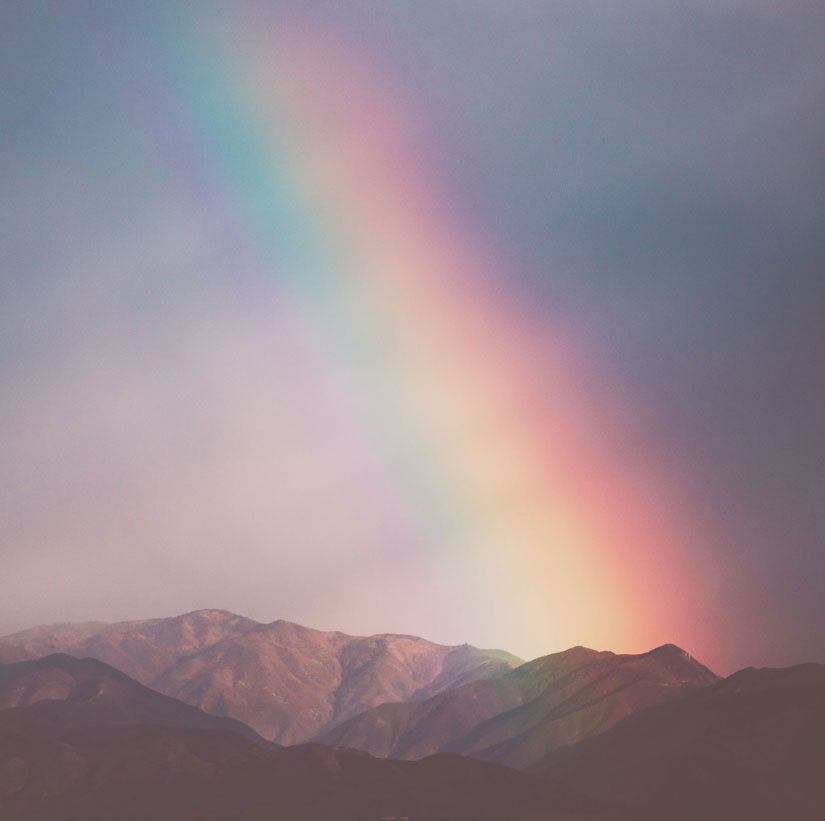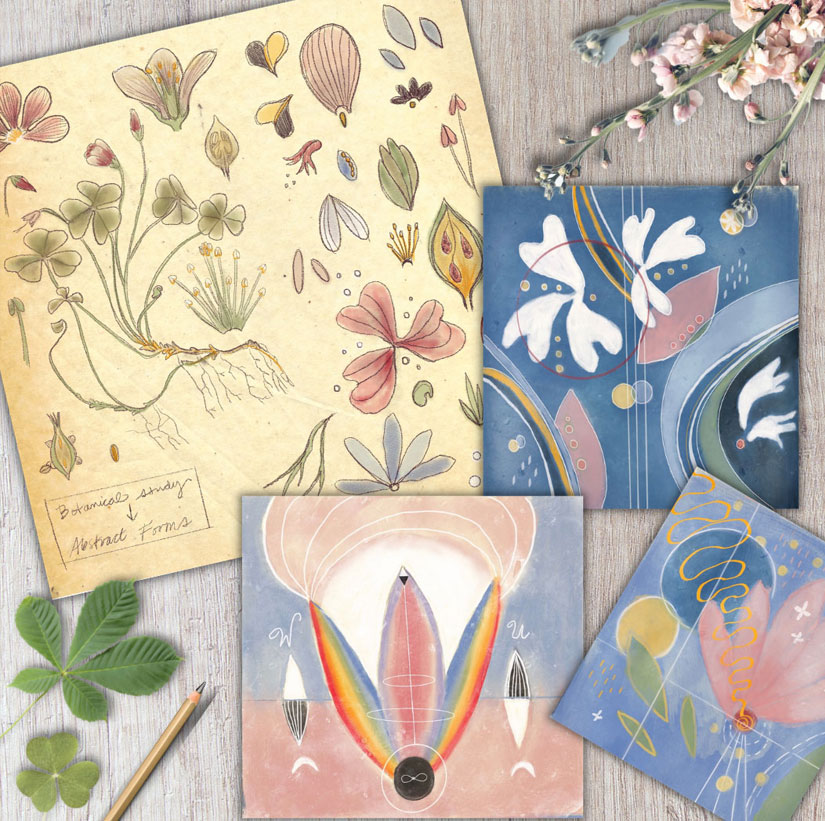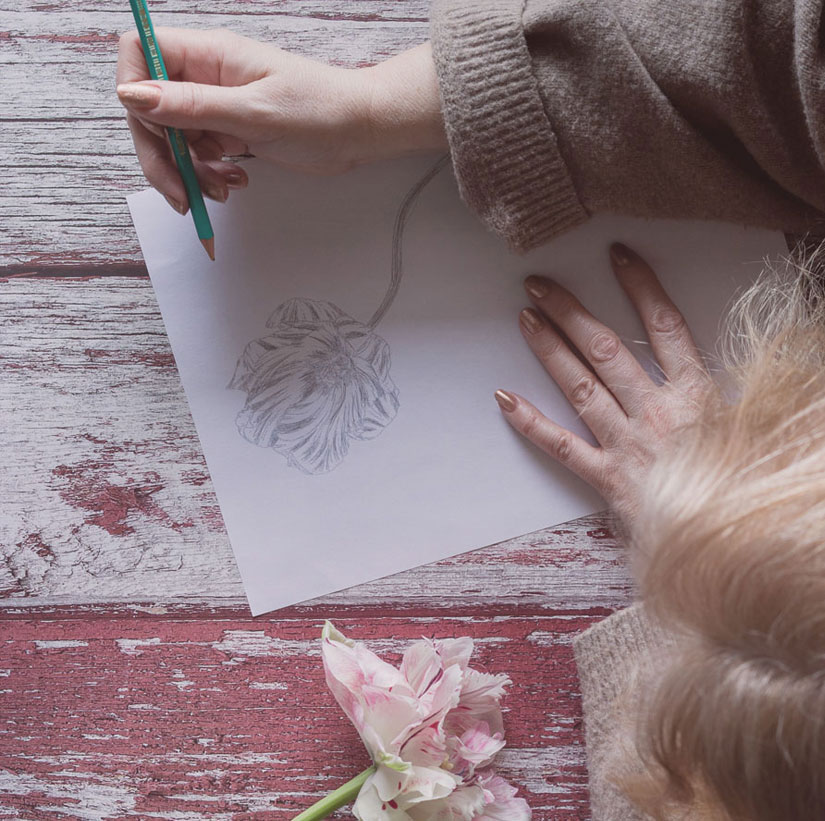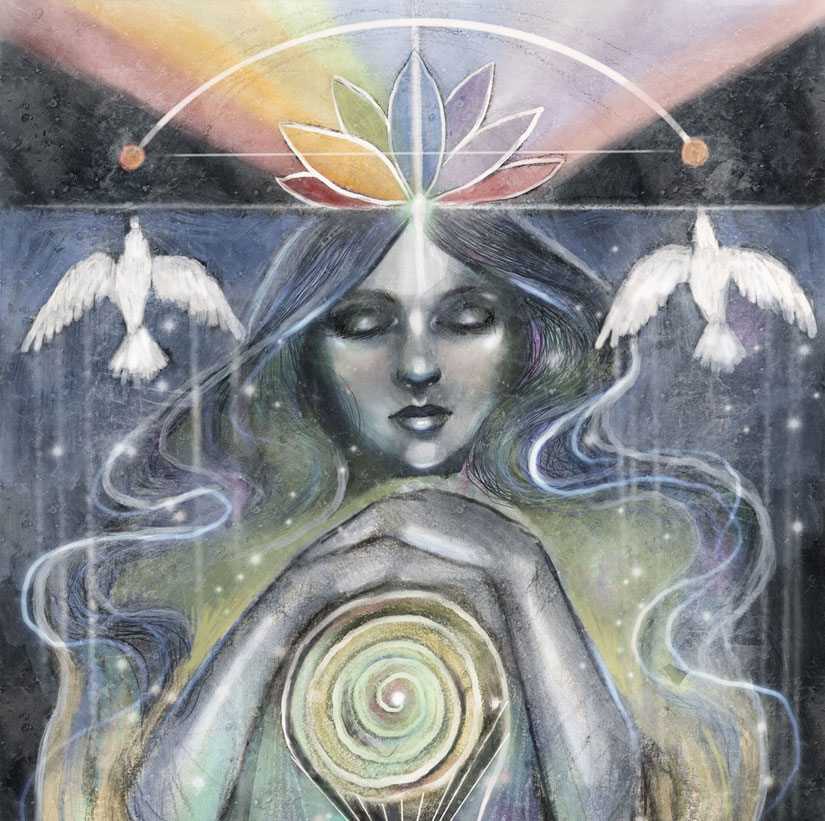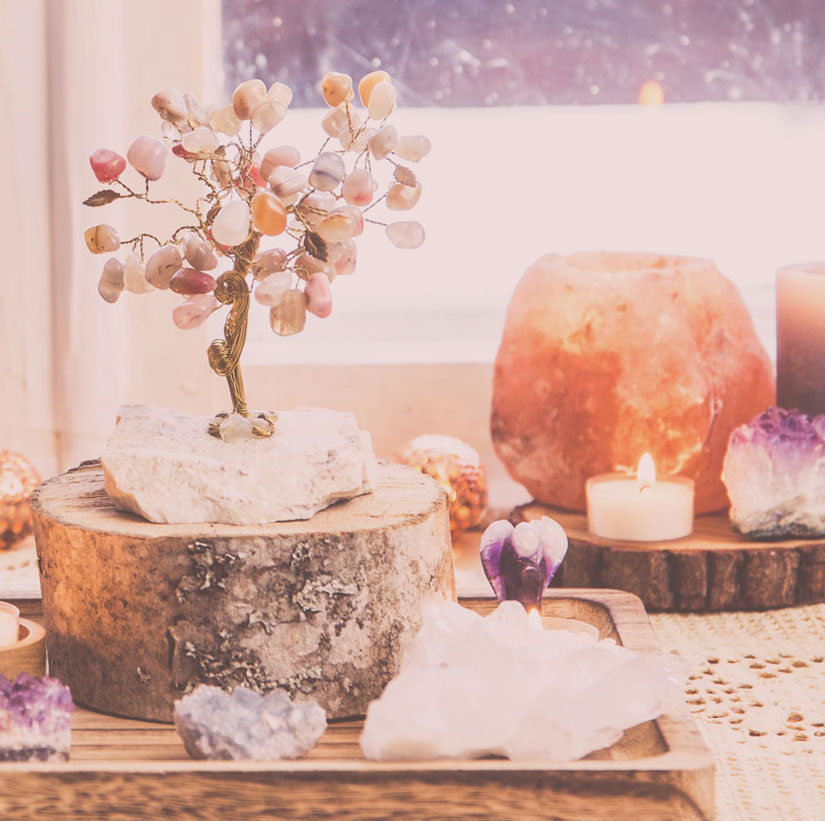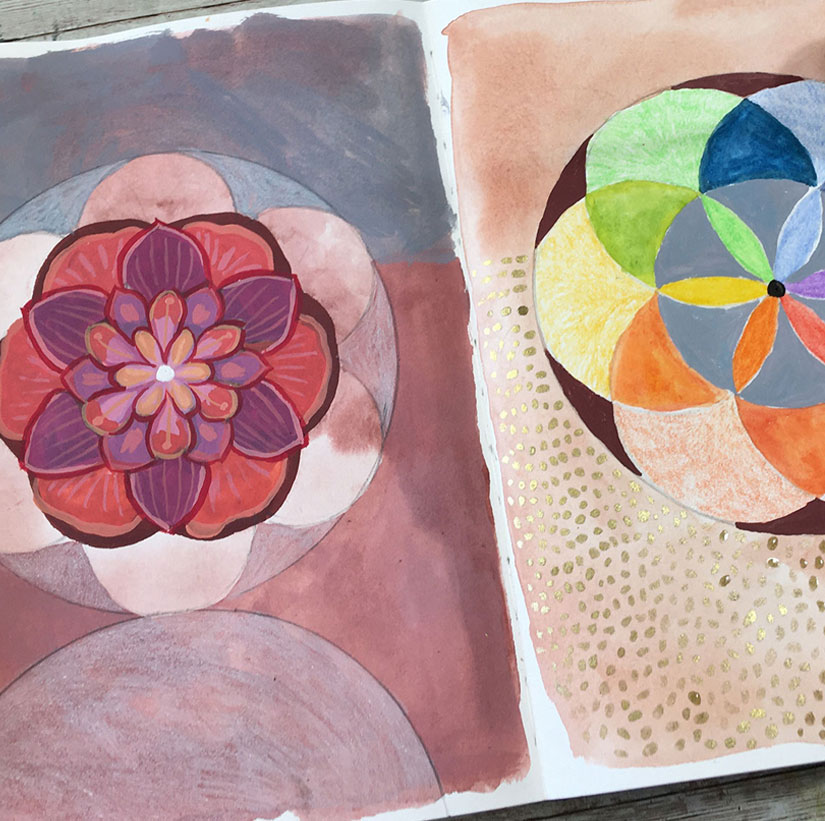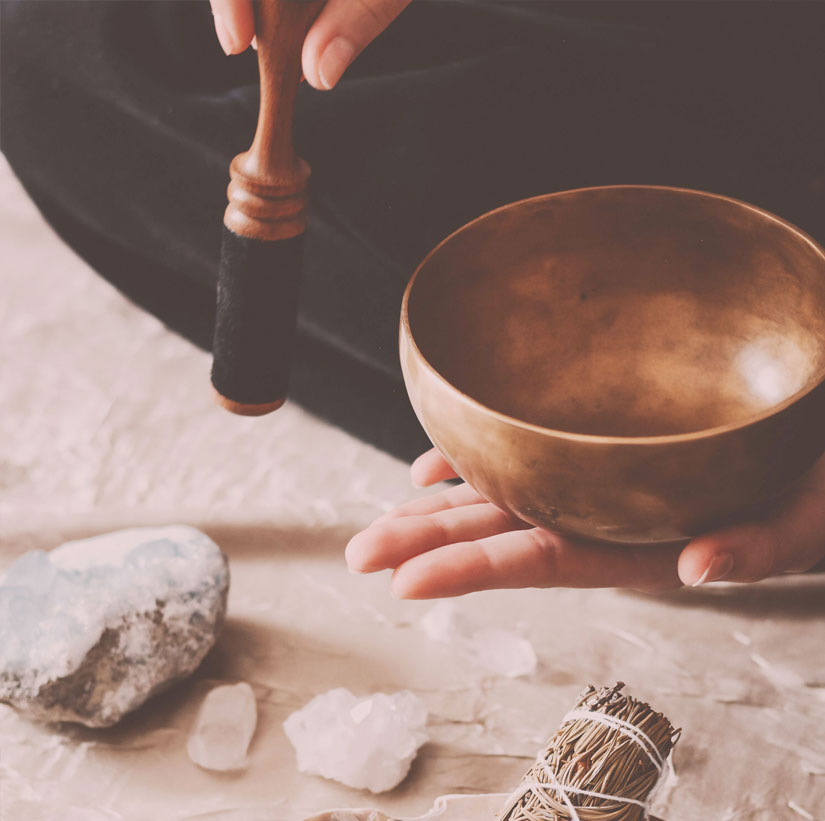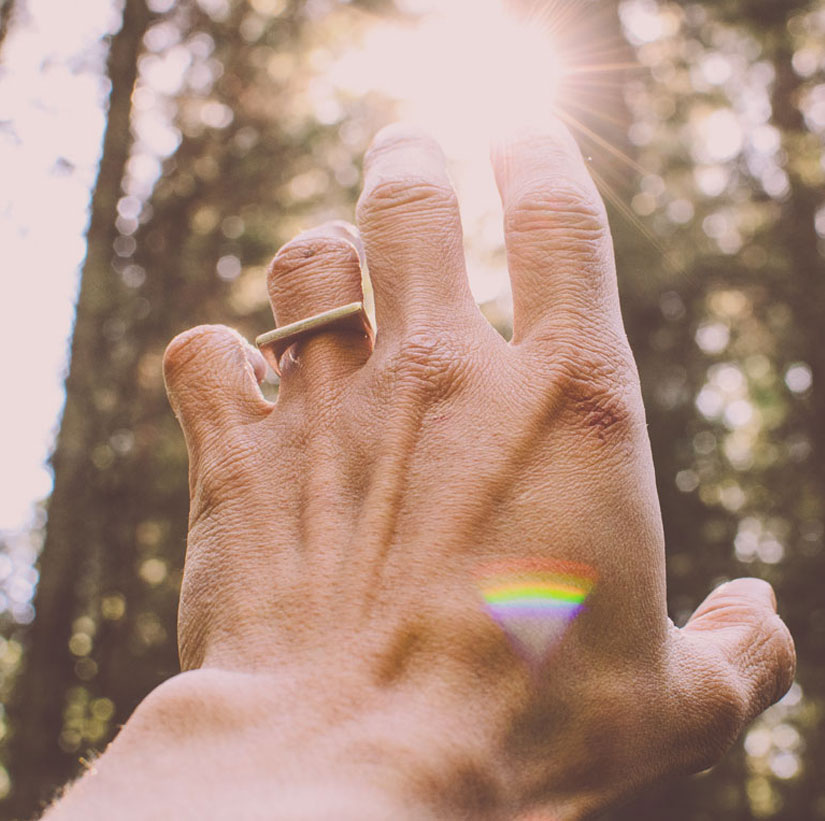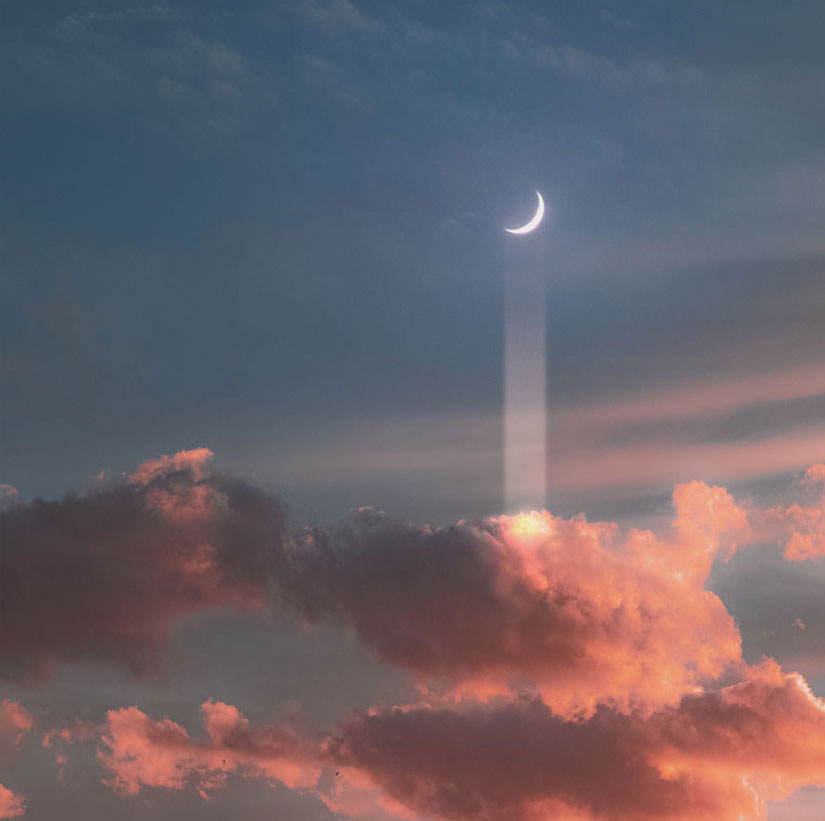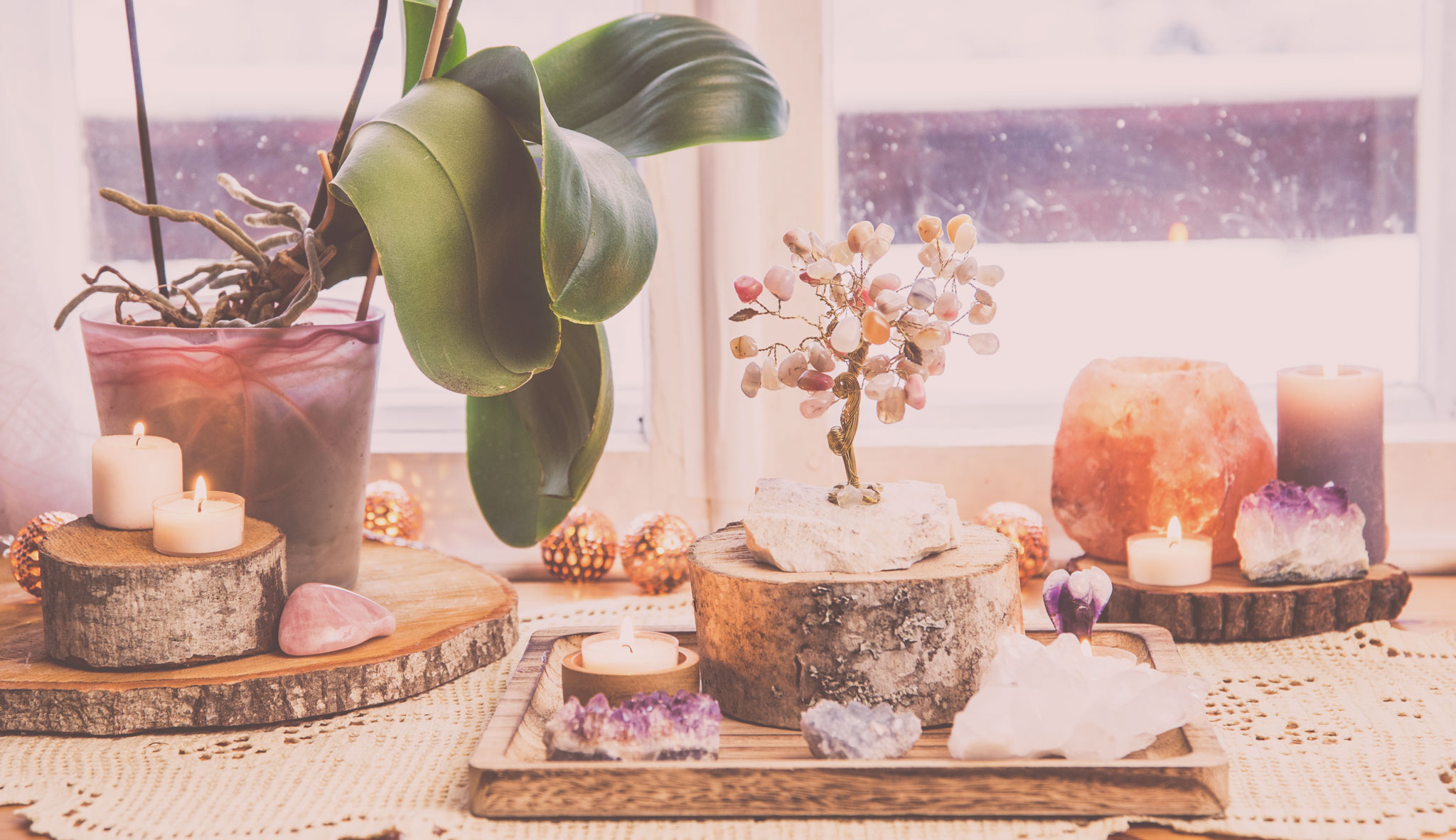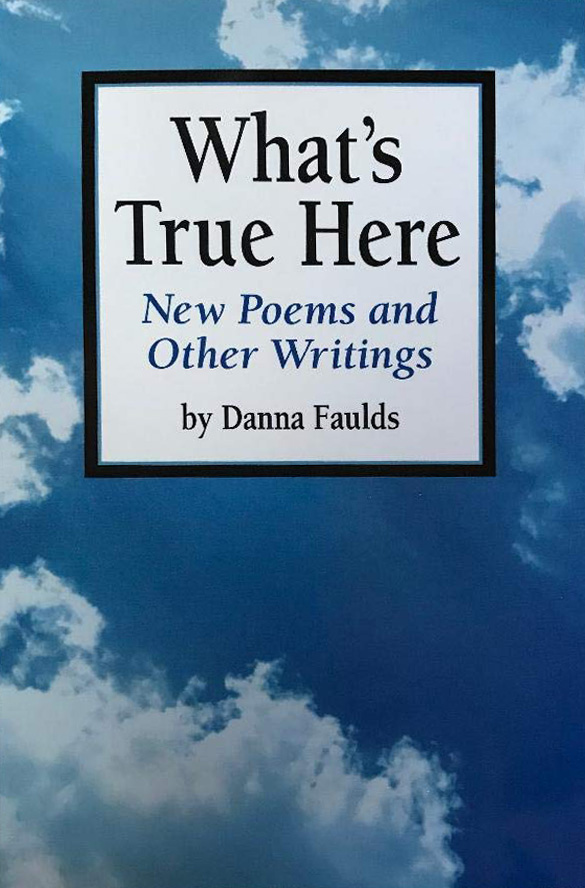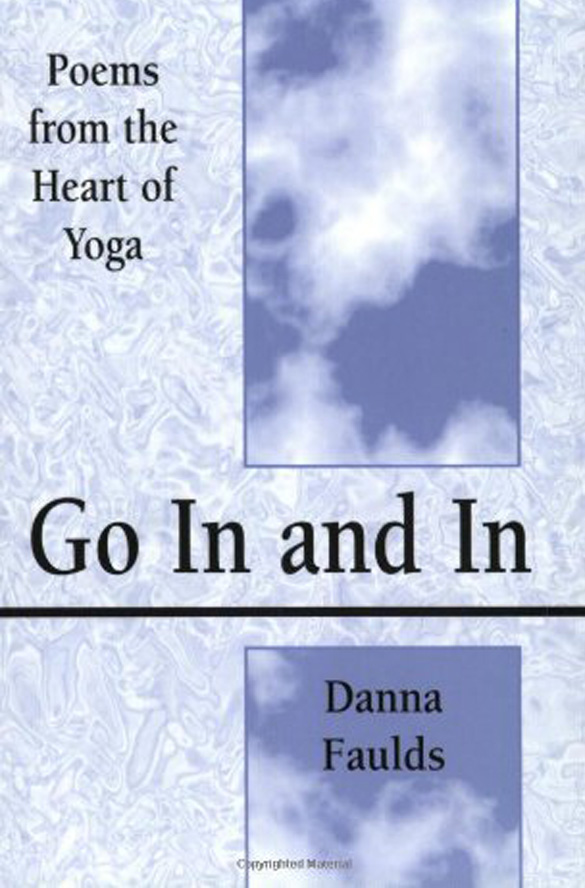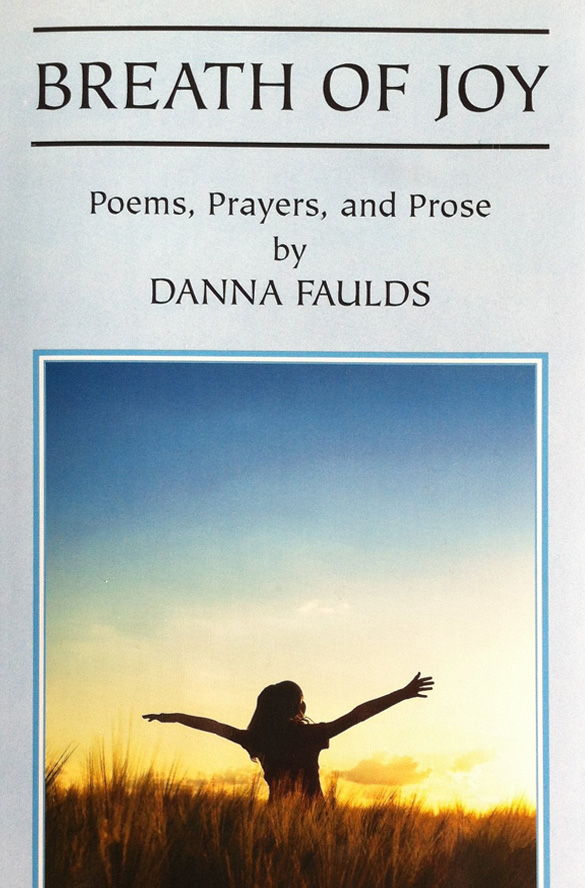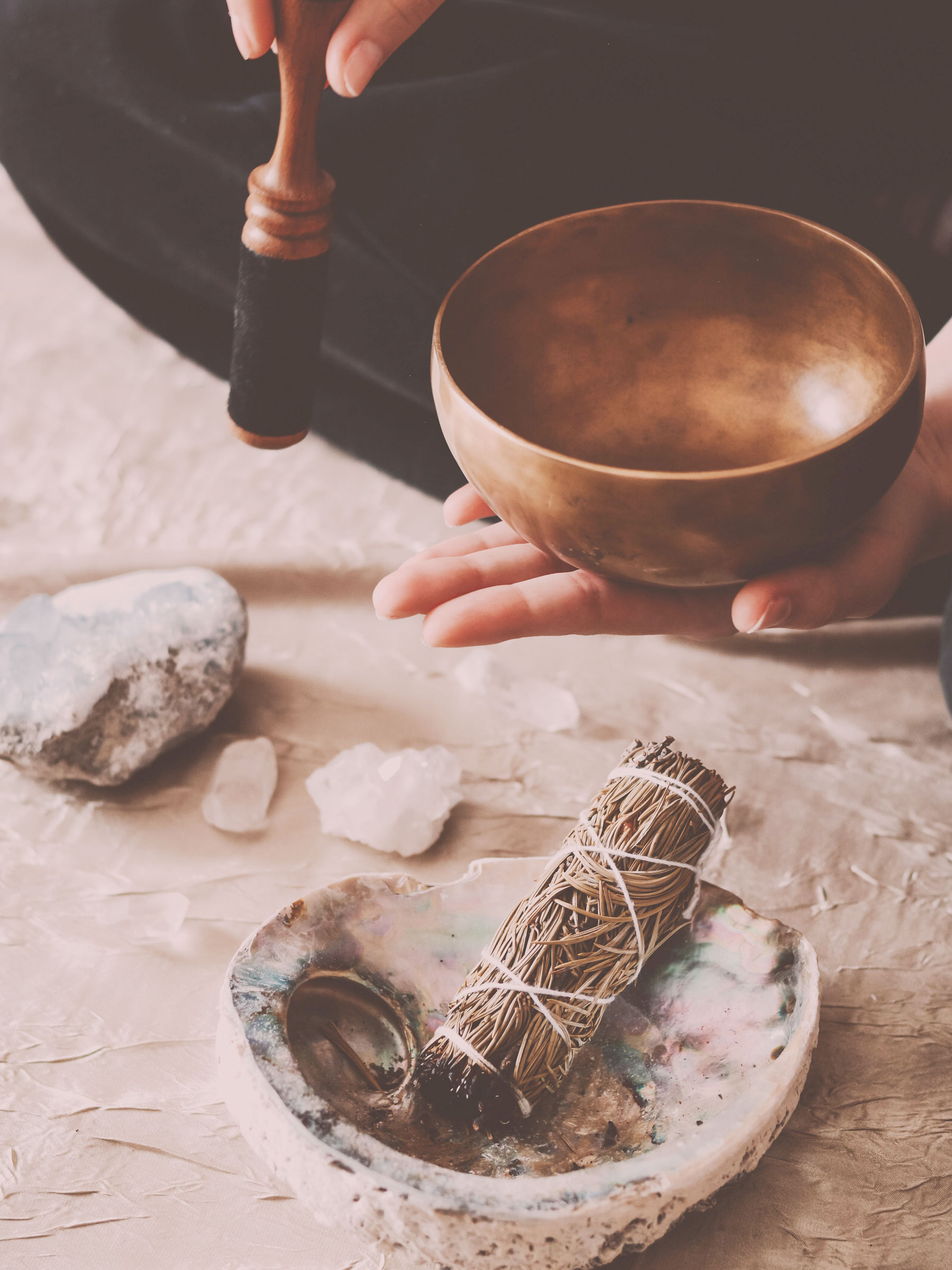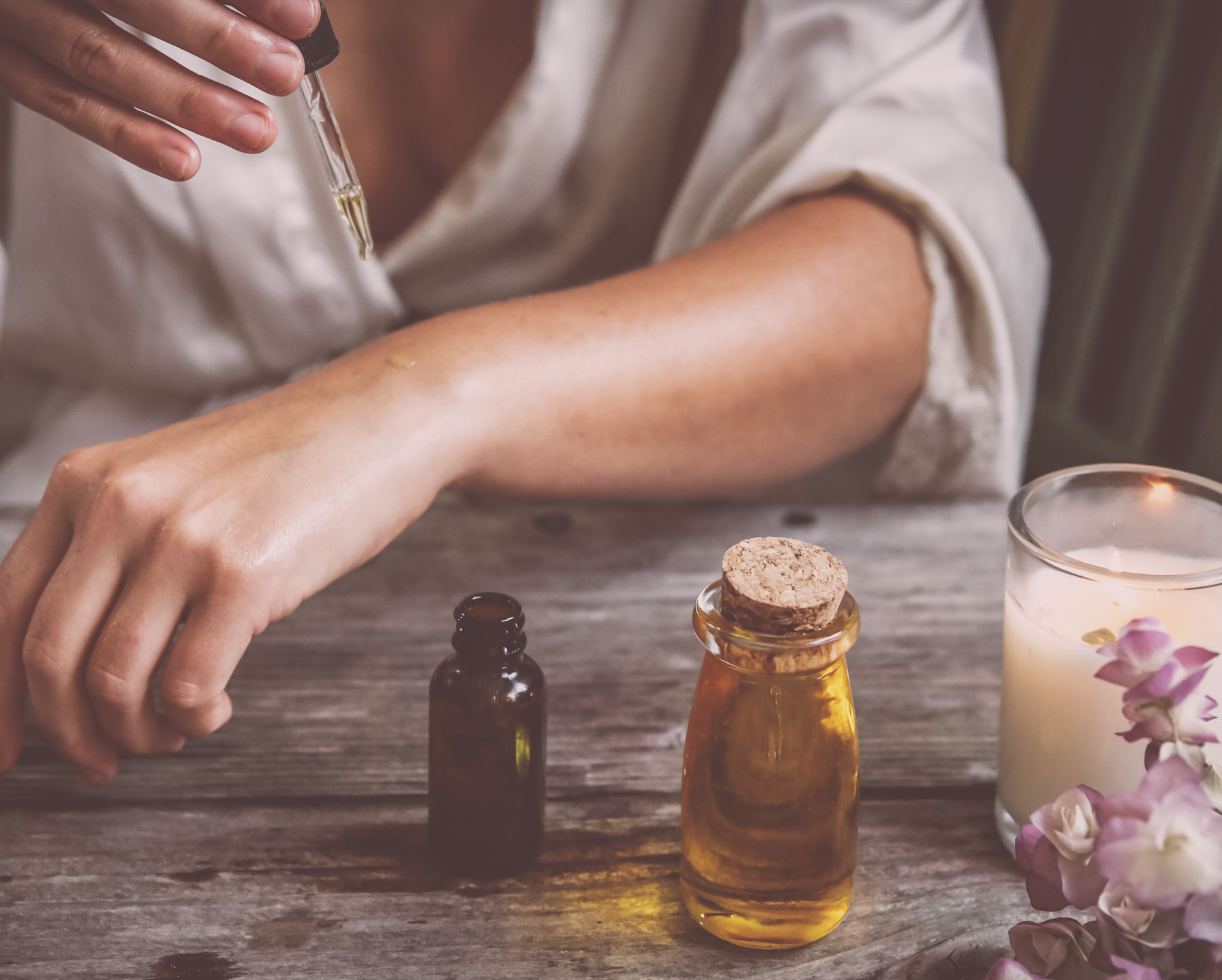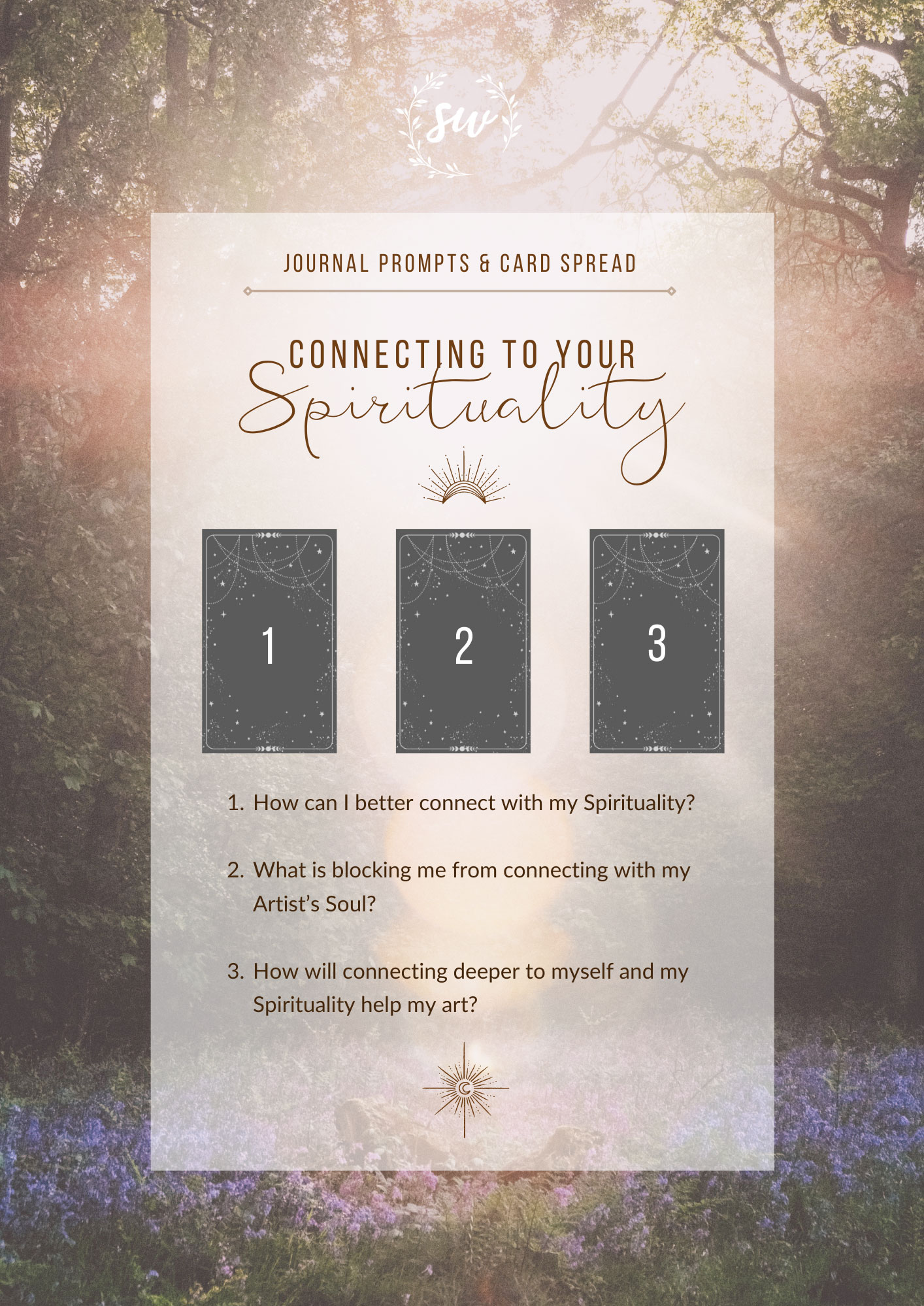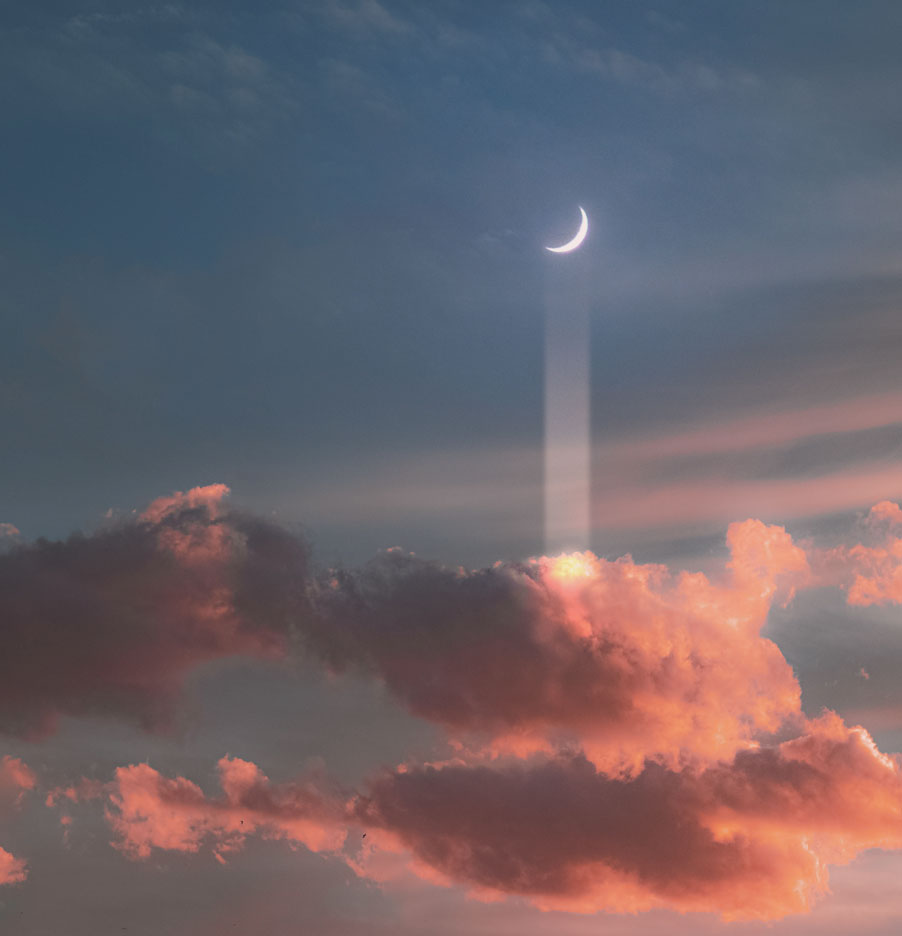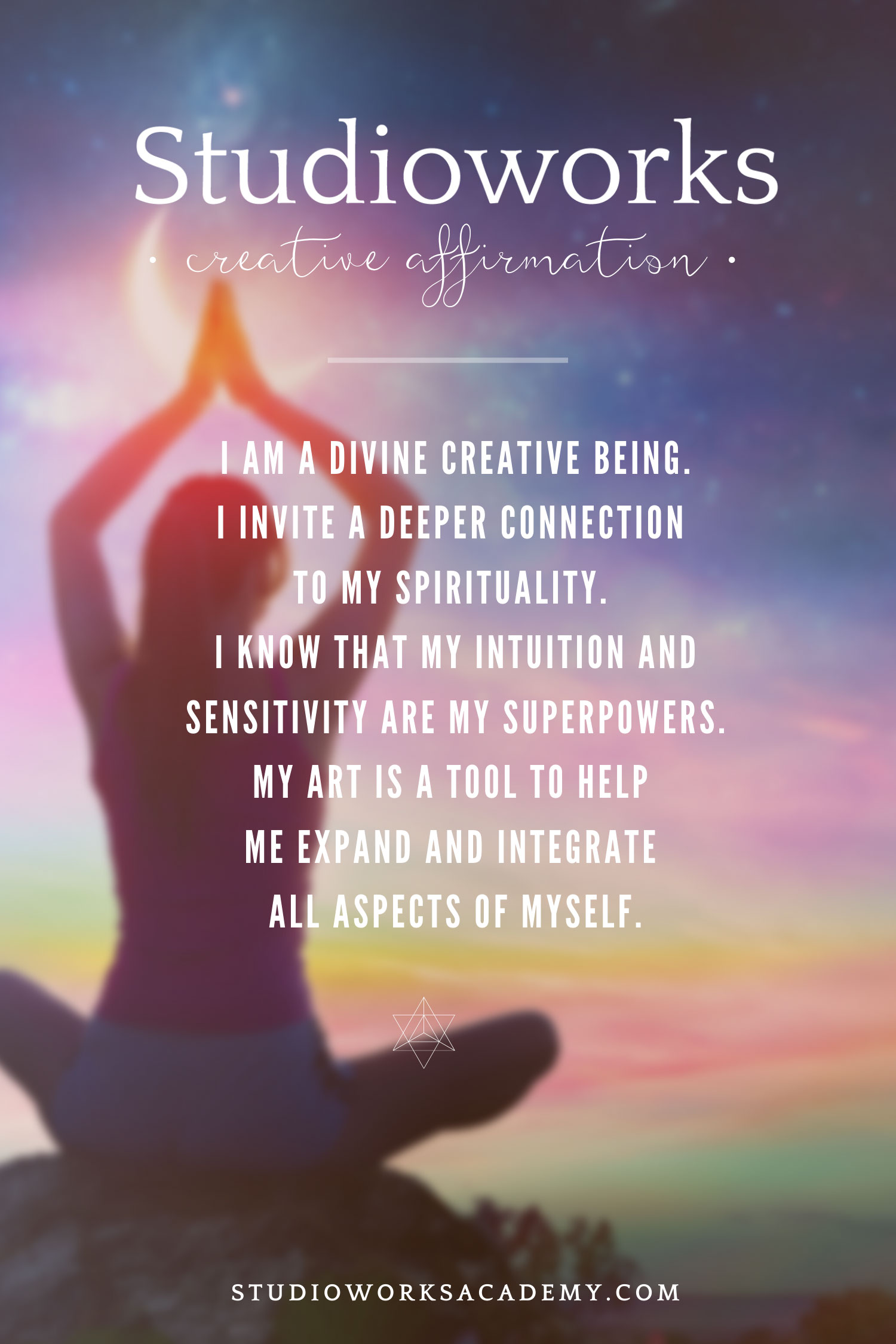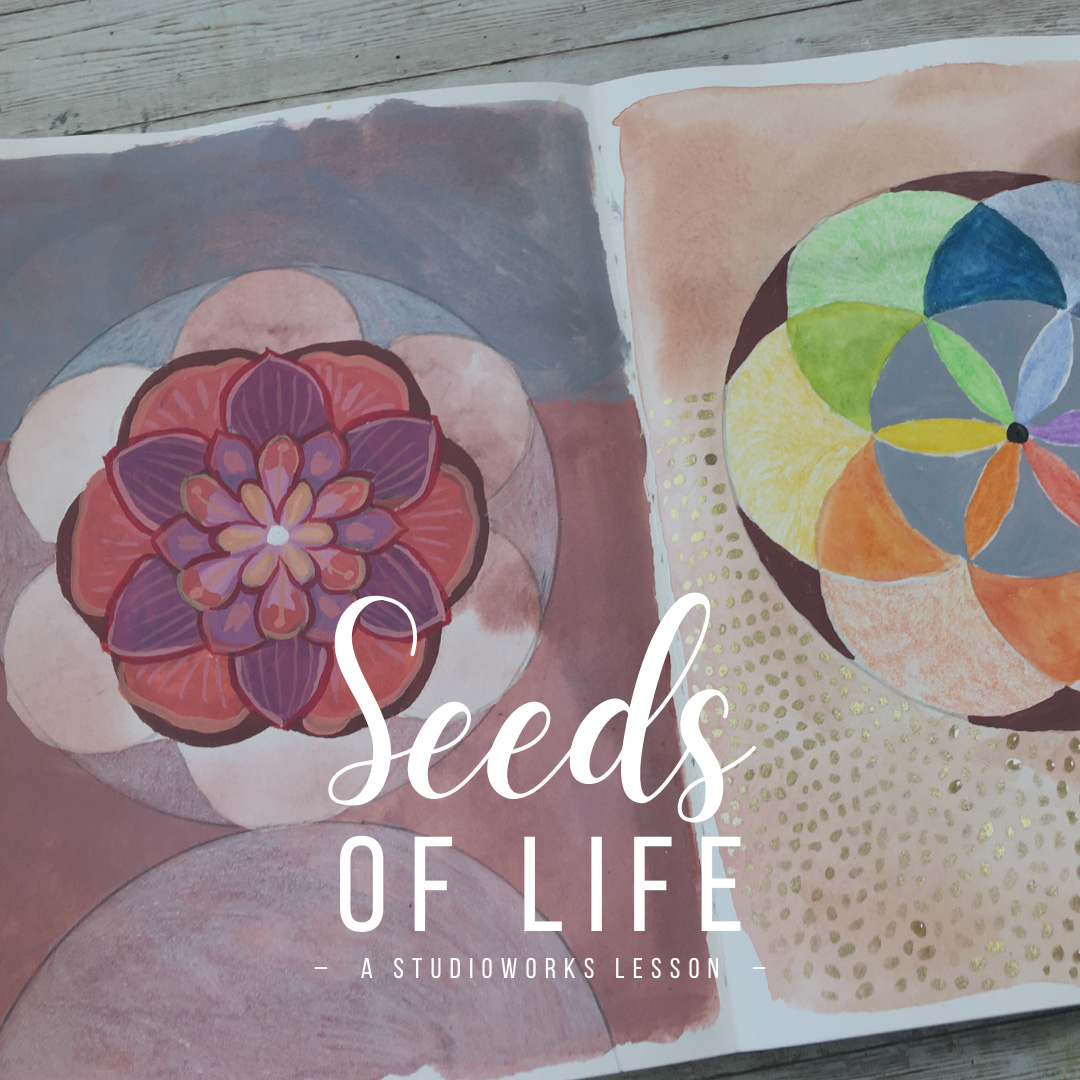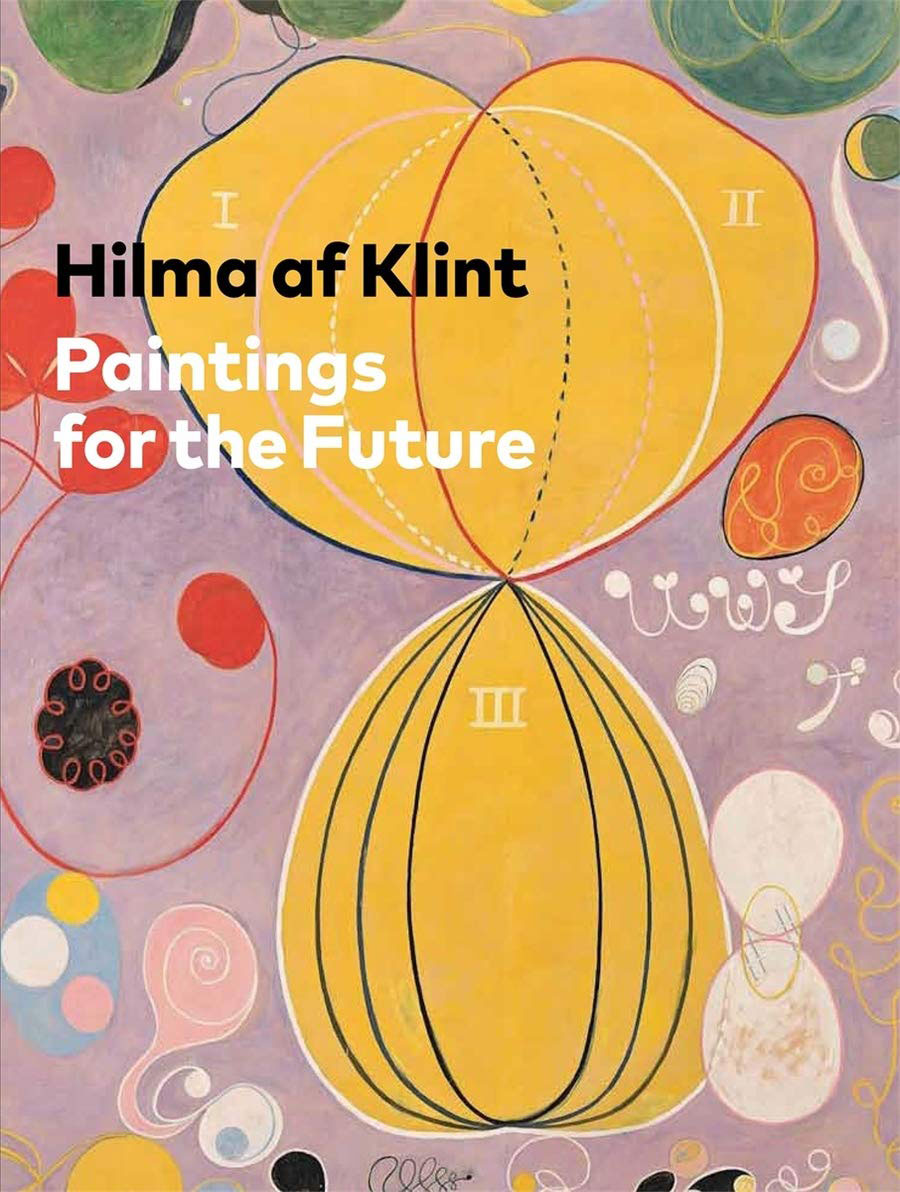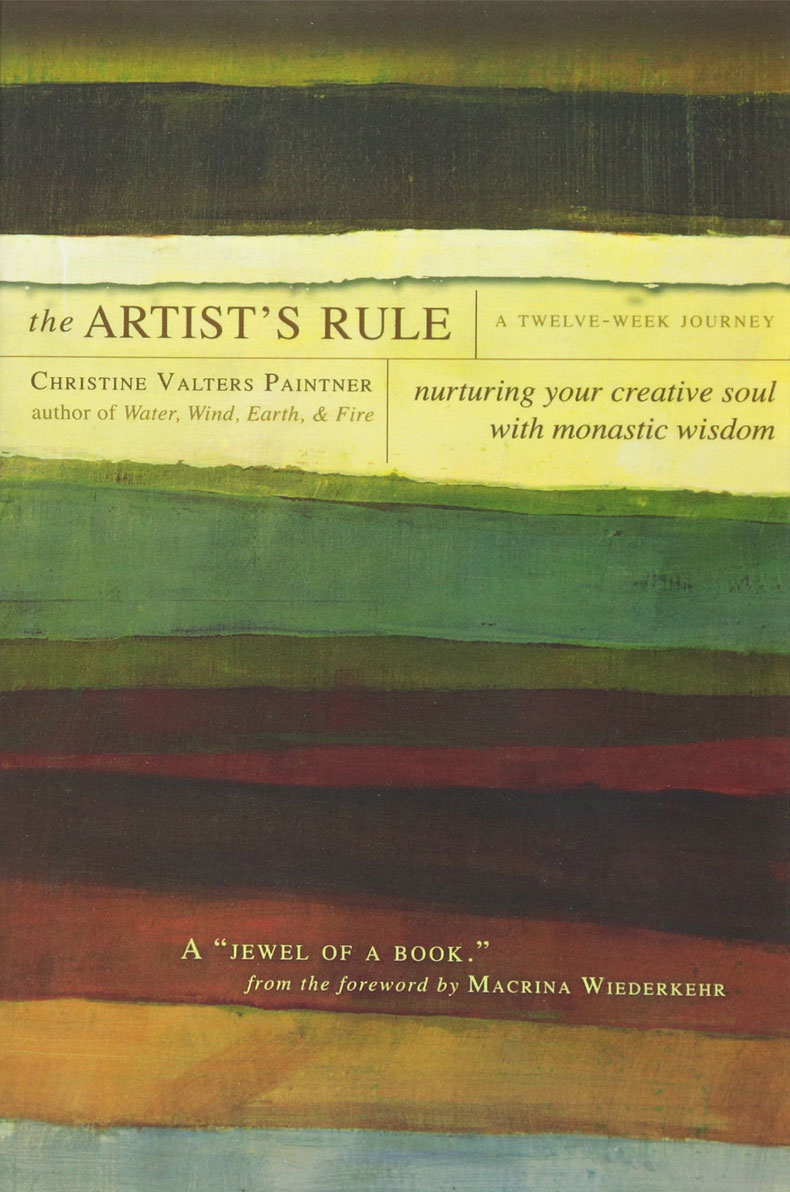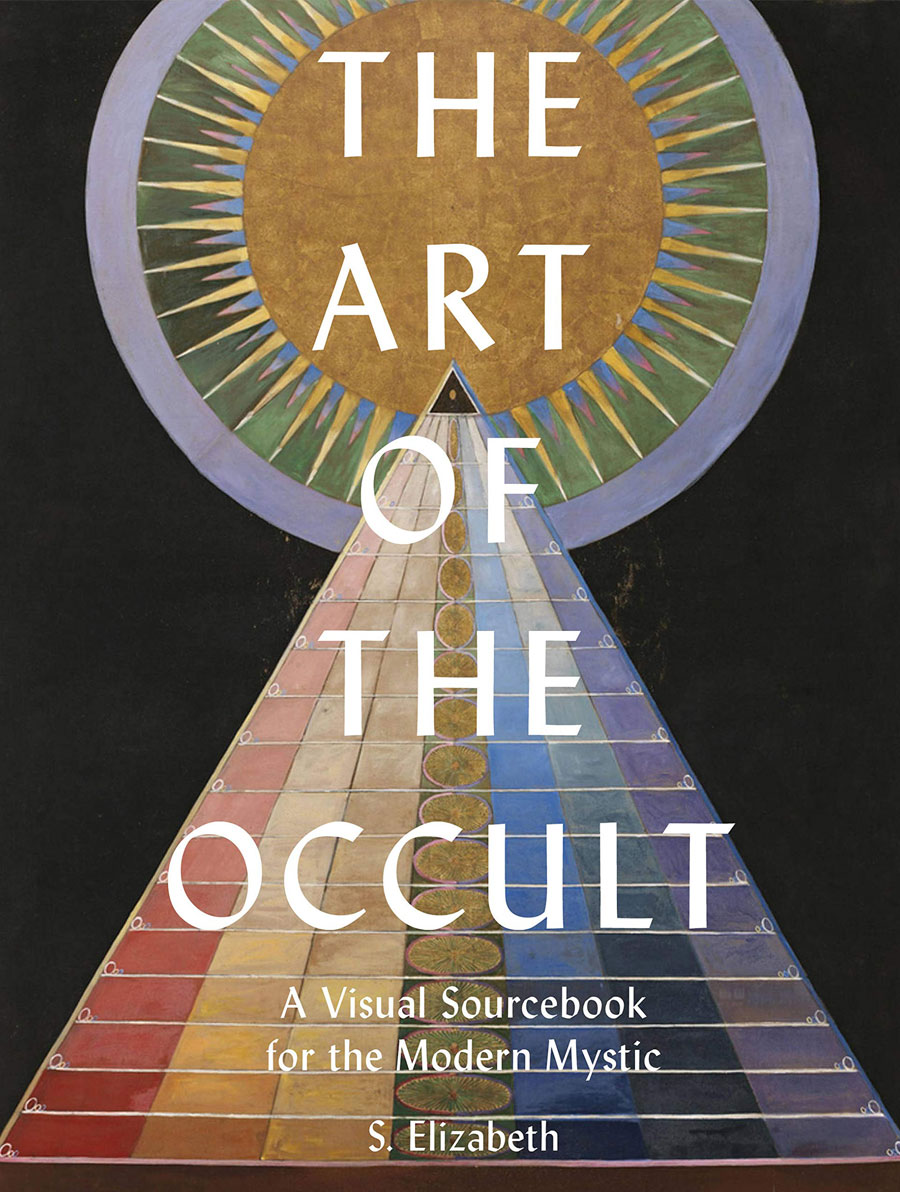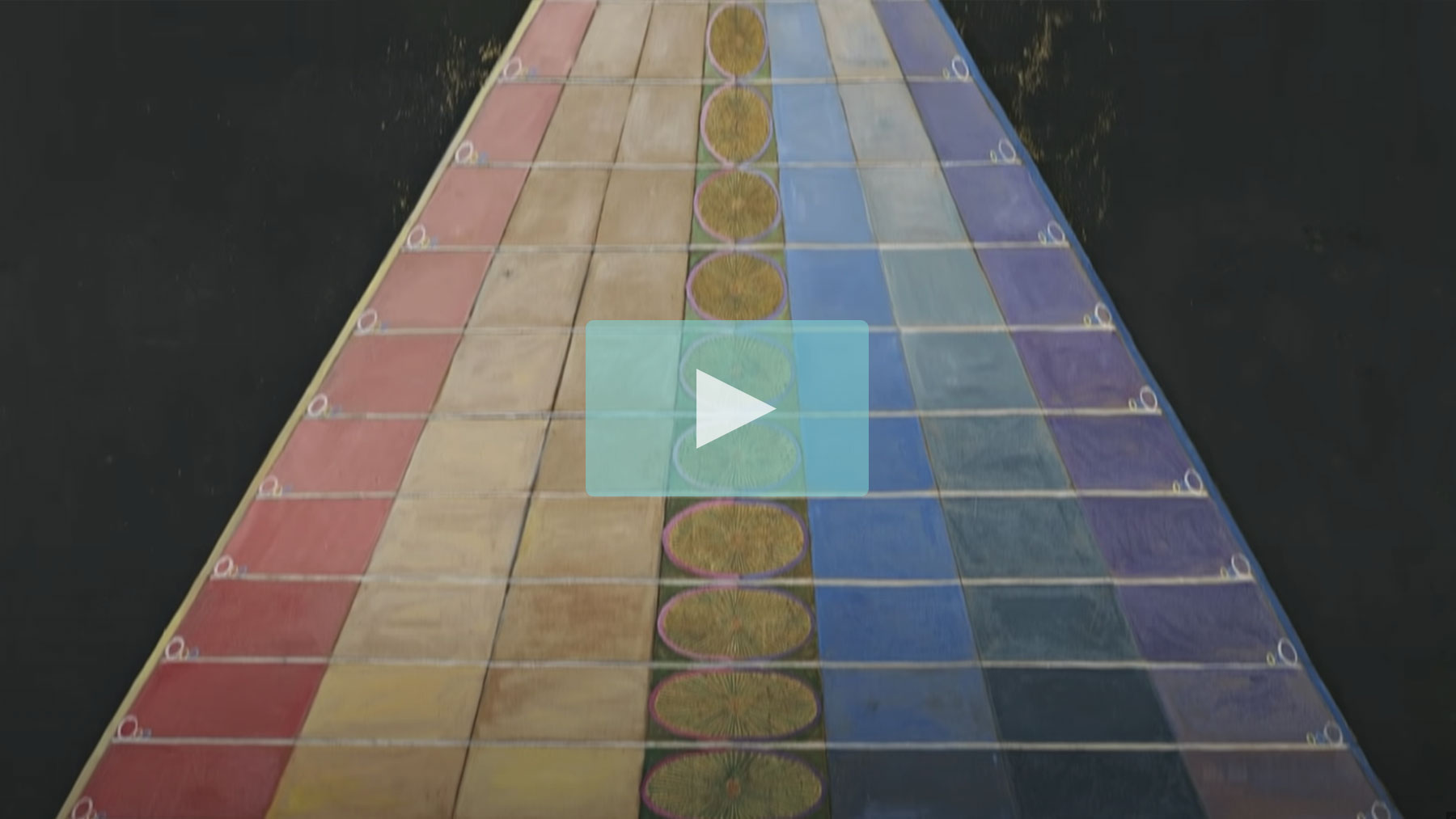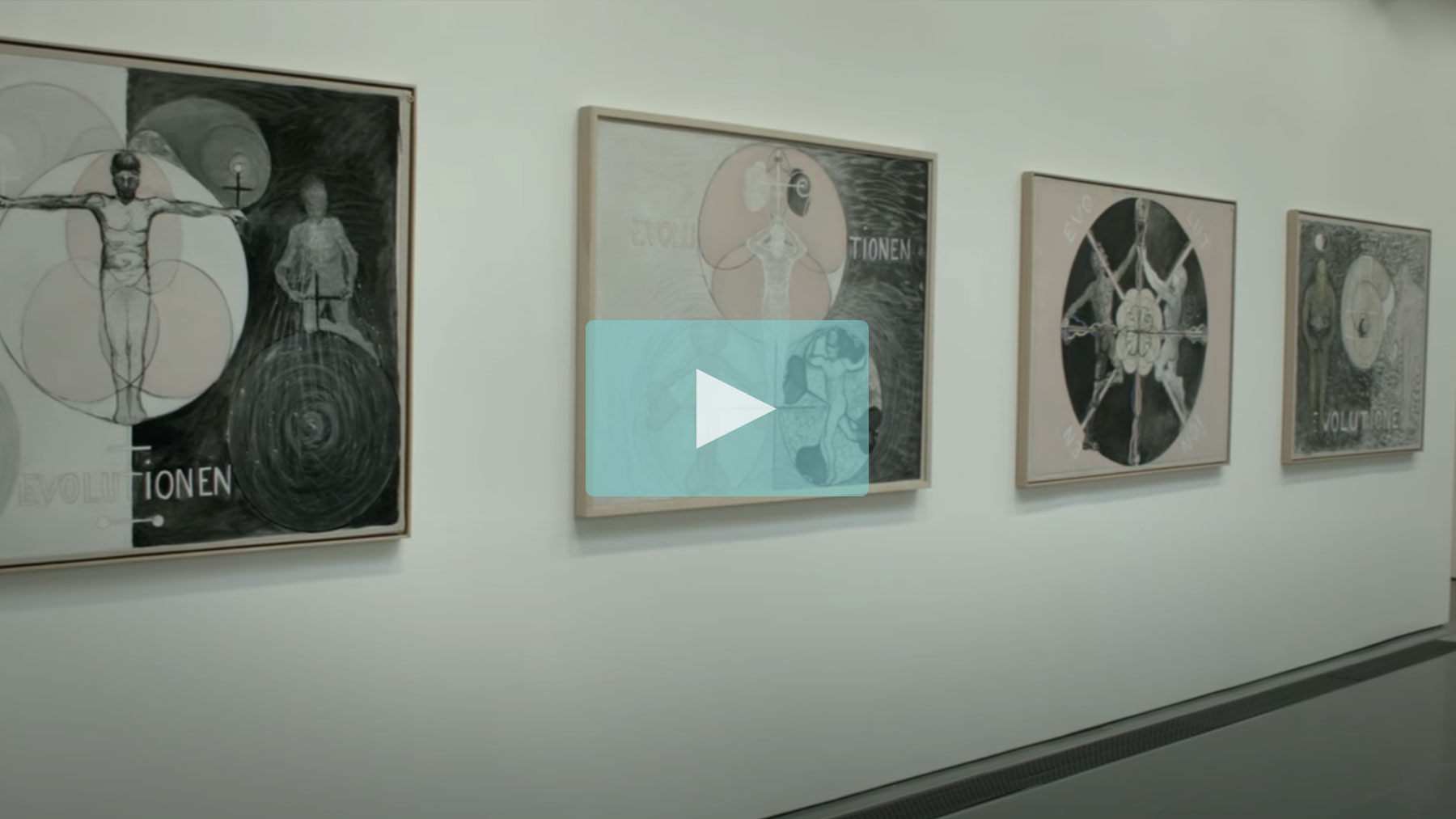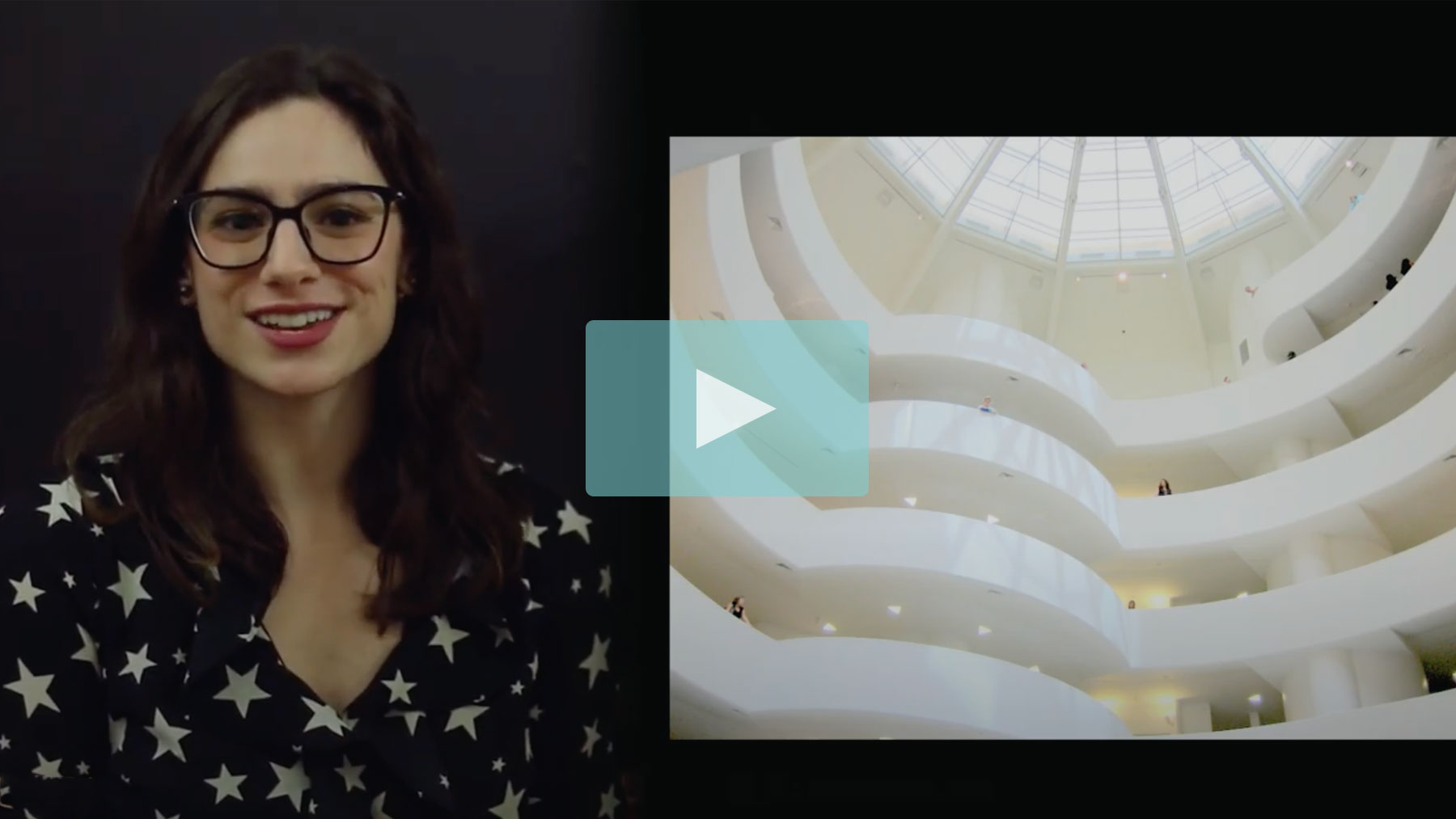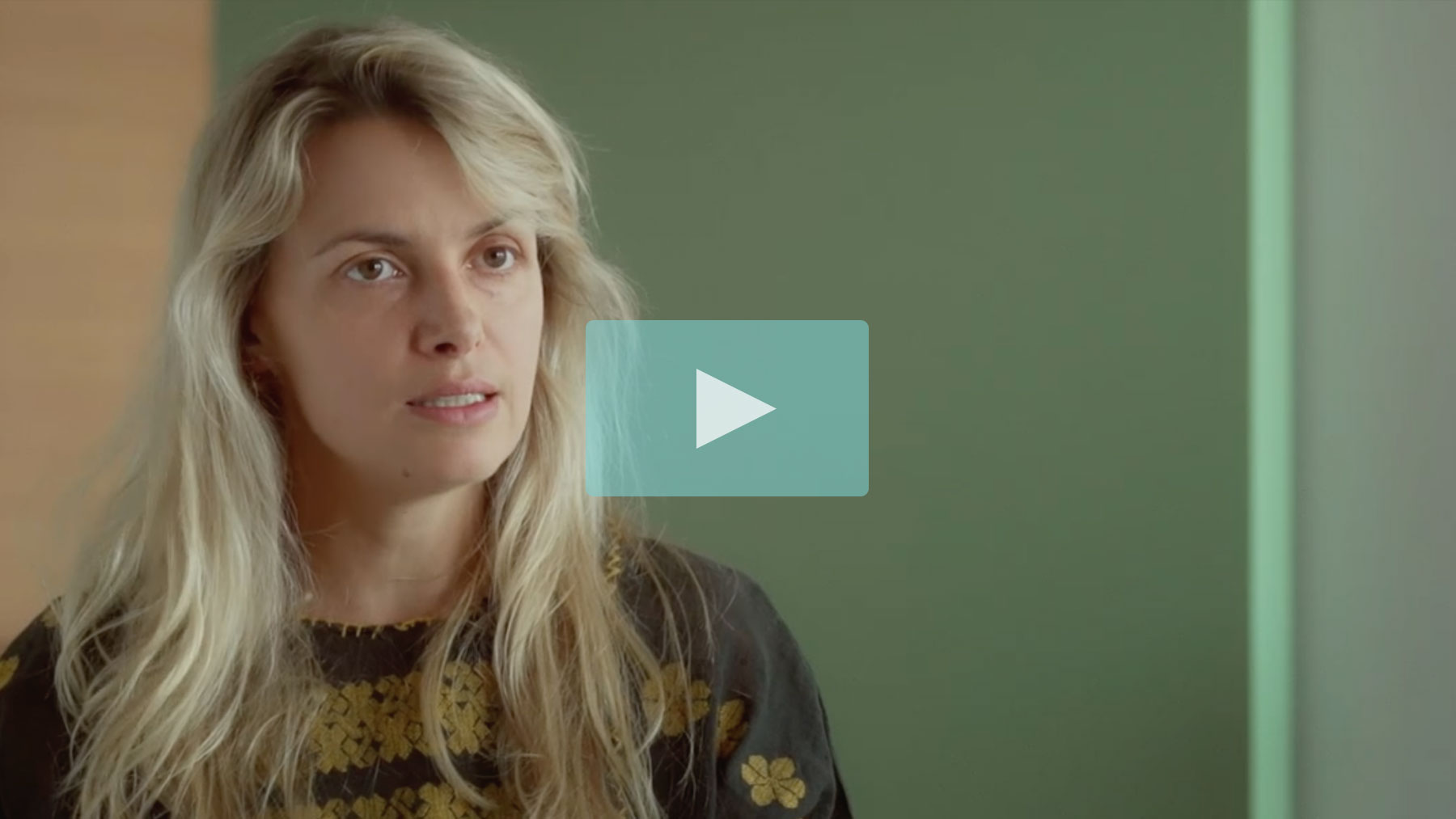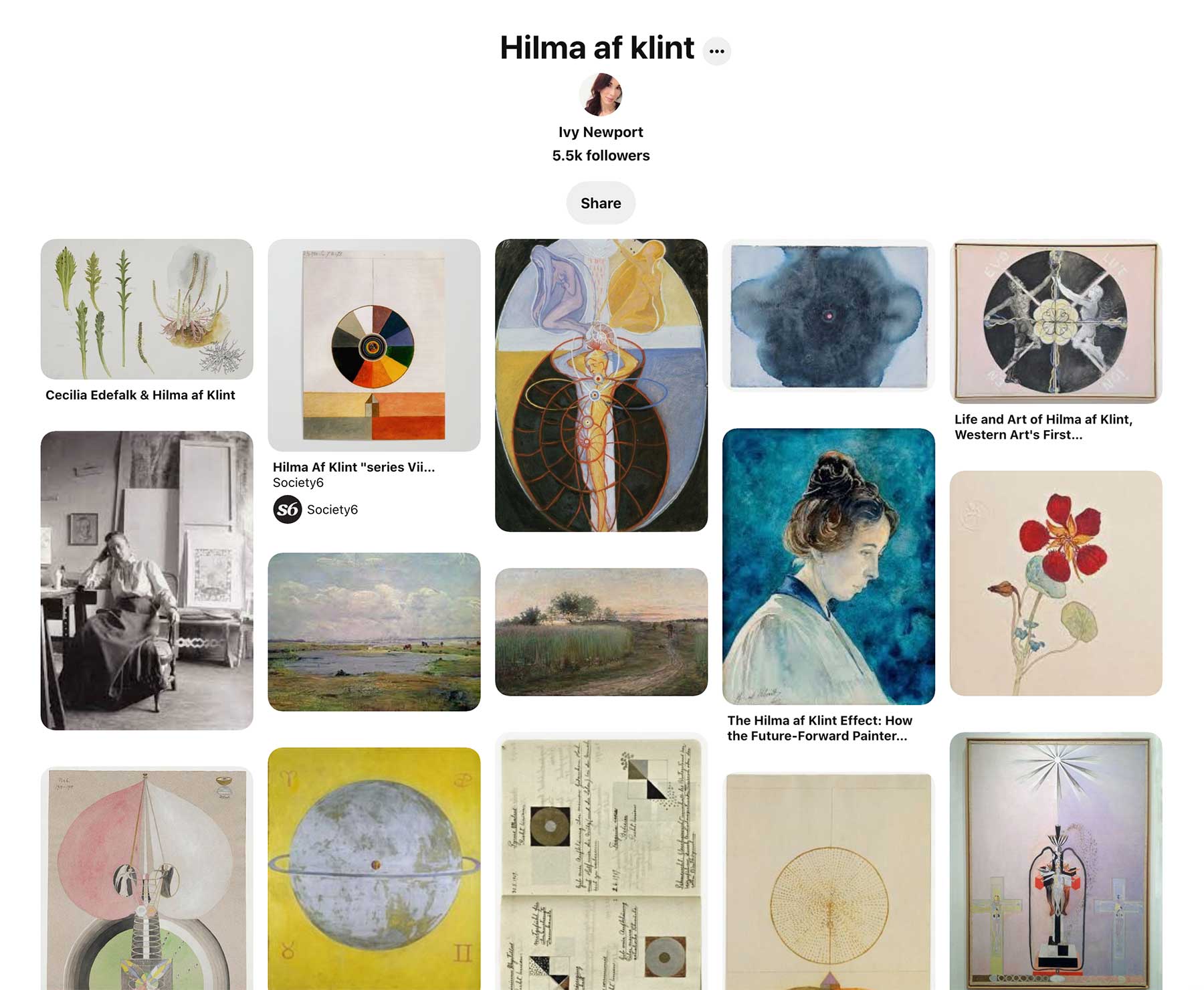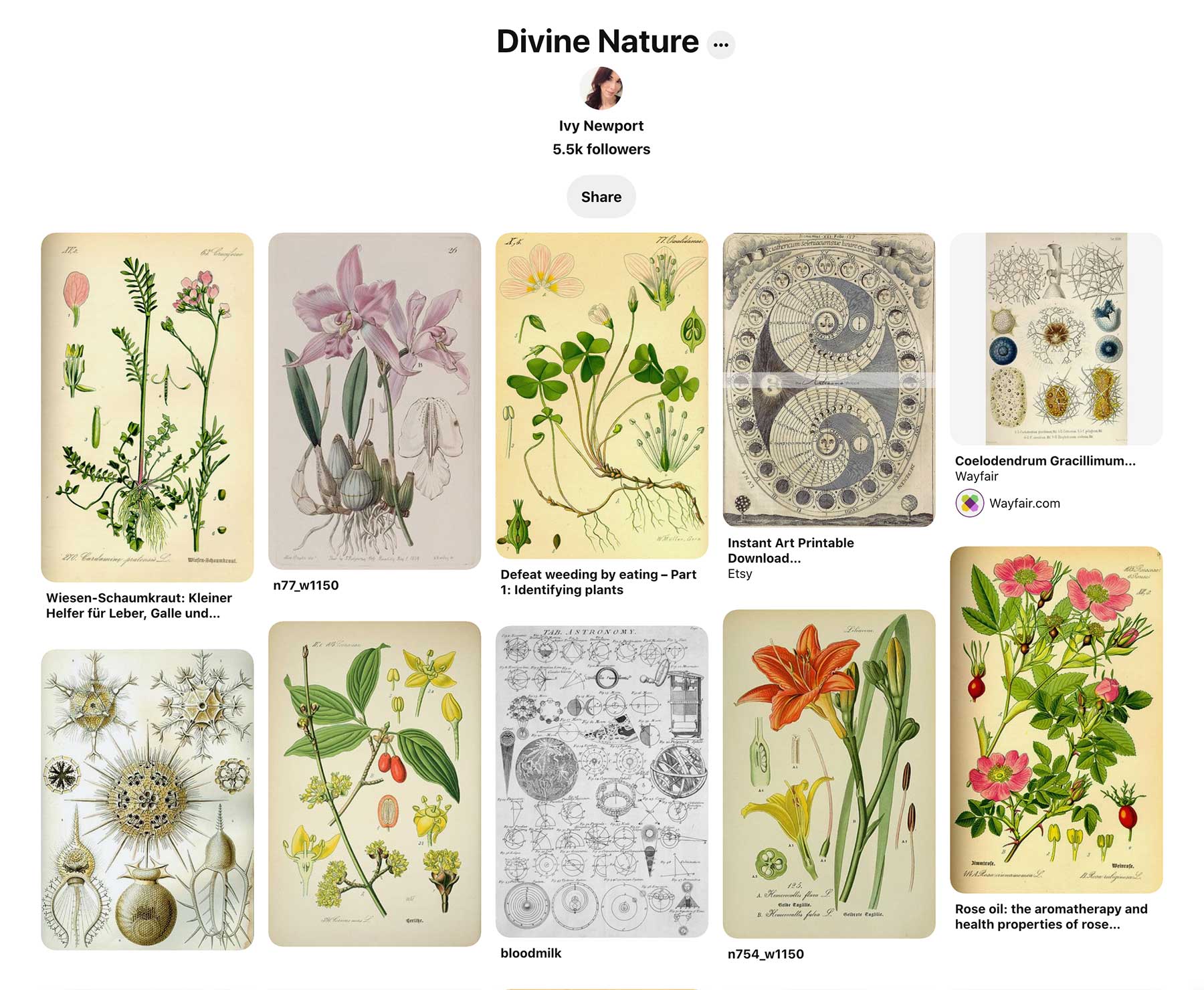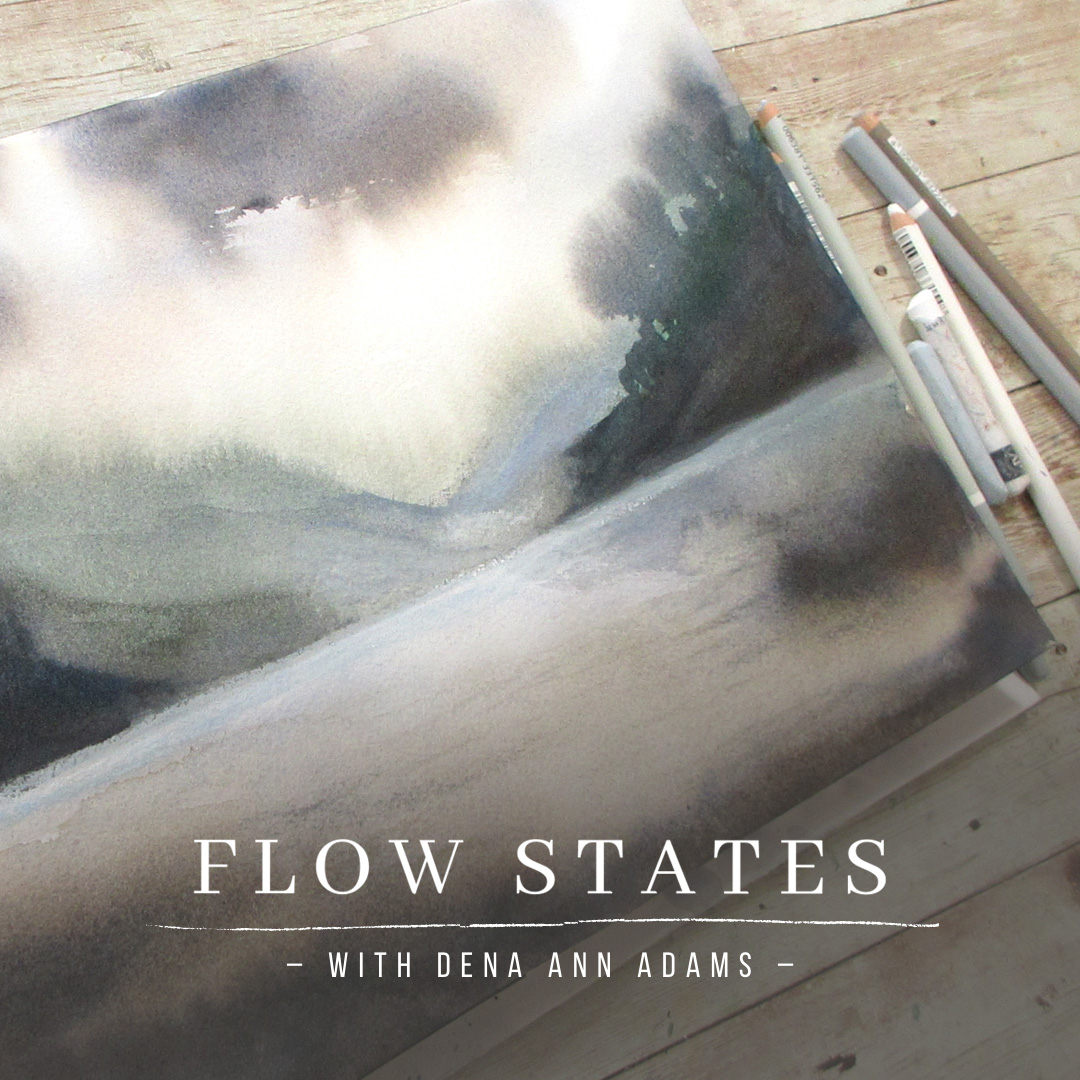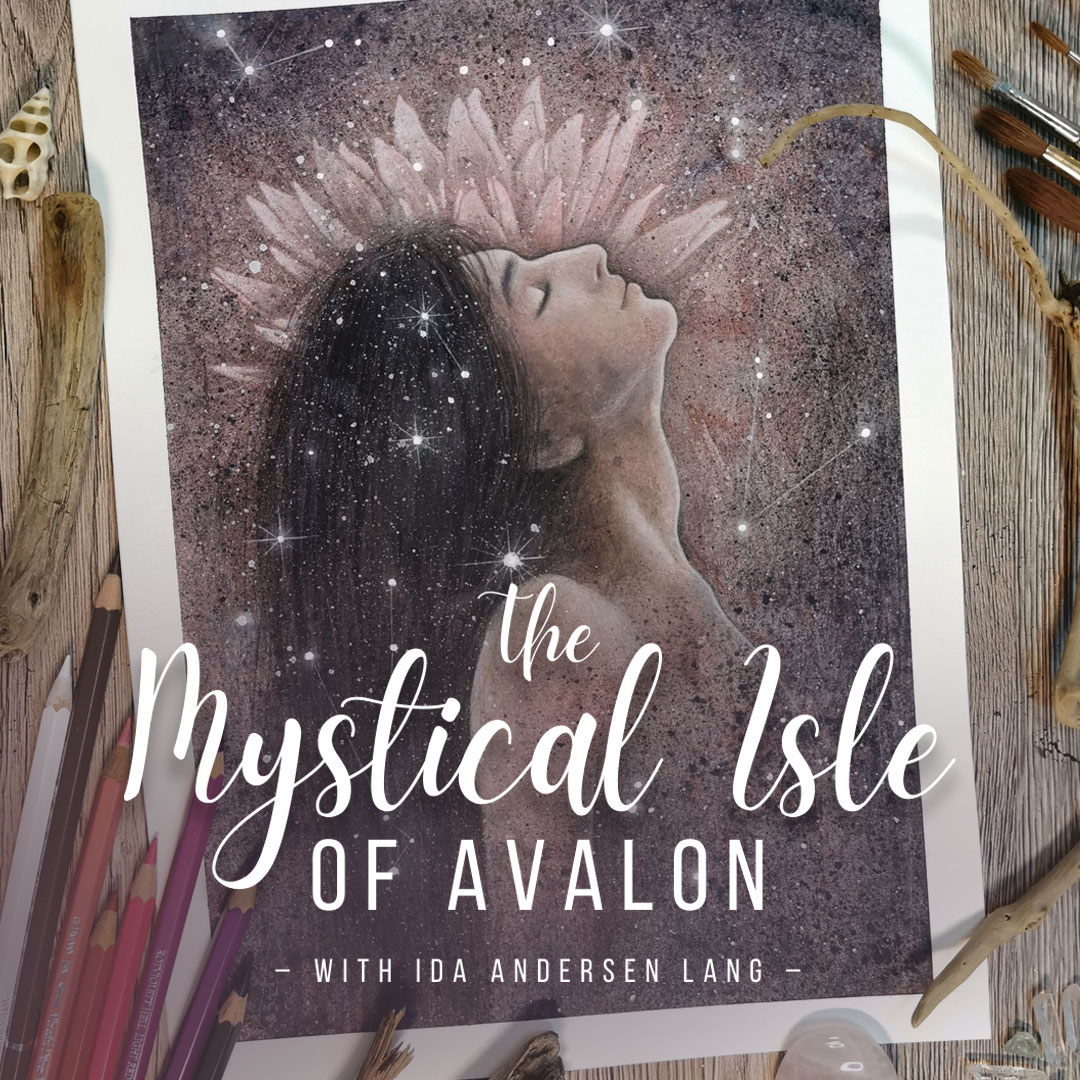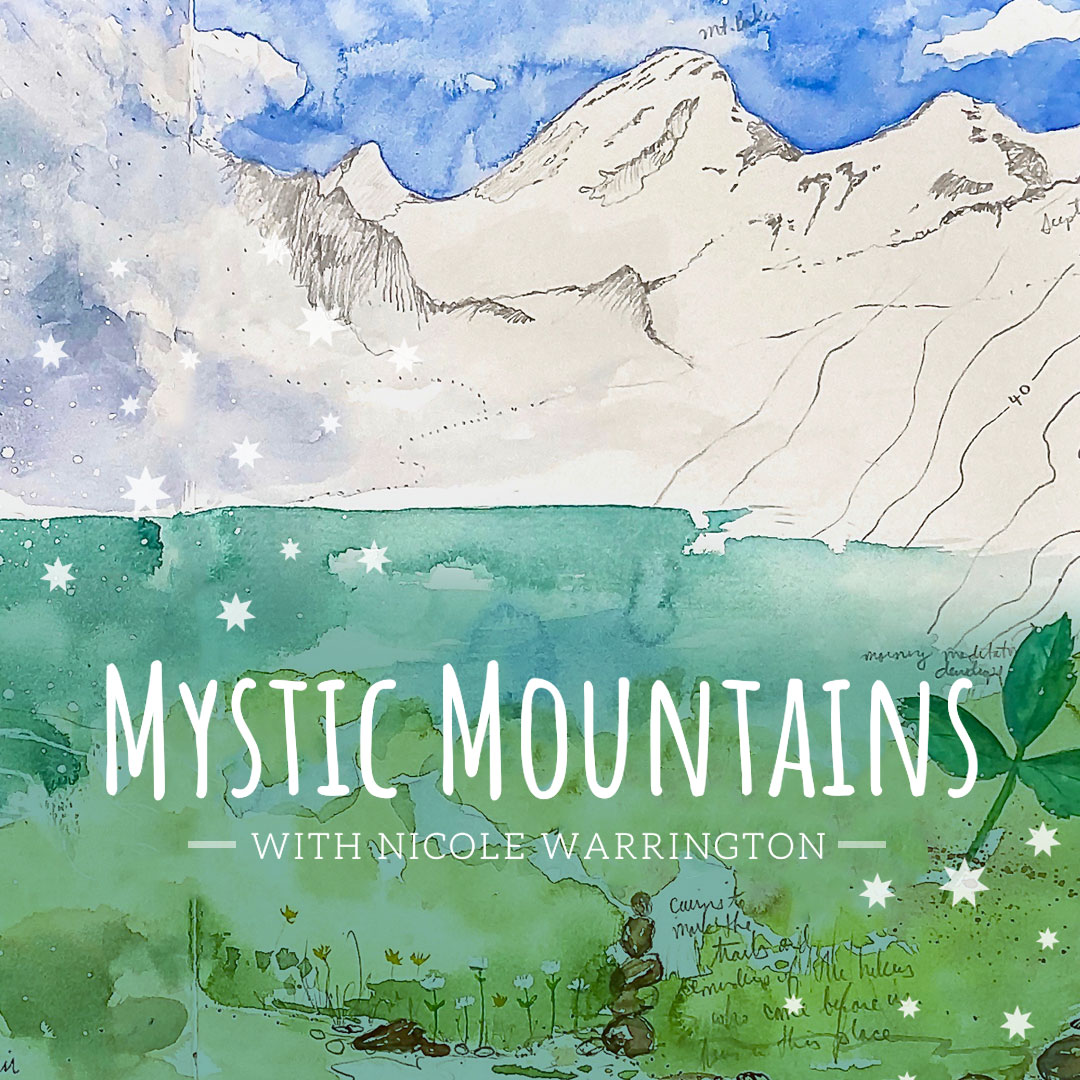IVY NEWPORT
Studioworks
Journal
a letter from ivy
Dear creative friends,
Welcome to Issue #31 of the Studioworks Journal! As always, I’m delighted you are here with me and I’m excited to share this with you. This month, I want to take a deeper dive with you. I want to explore the sacred in Art, the Spirit of Art. By that, I mean going beyond the idea that art is simply about replicating something we see in nature, or a face or an object but rather unpack the spiritual side of Art making. Now, obviously, spirituality is incredibly personal and I invite you to stay true to the path that feels most in alignment to you but I do believe that there are many opportunities and invitations that Art provides to deepen our relationship with ourselves and our spiritual life. I must note, that I am not directly speaking about religion, although religion may be a part of your spiritual life, rather, I speak of our relationship to self, to our art, to nature and to the world at large.
It is only natural that once we begin to explore the sacred and the spiritual that we also investigate the concepts of devotion and ritual. How can these aspects be interwoven into our creative life? How can we commune deeper with our artistic self?
Let’s begin…
xo,

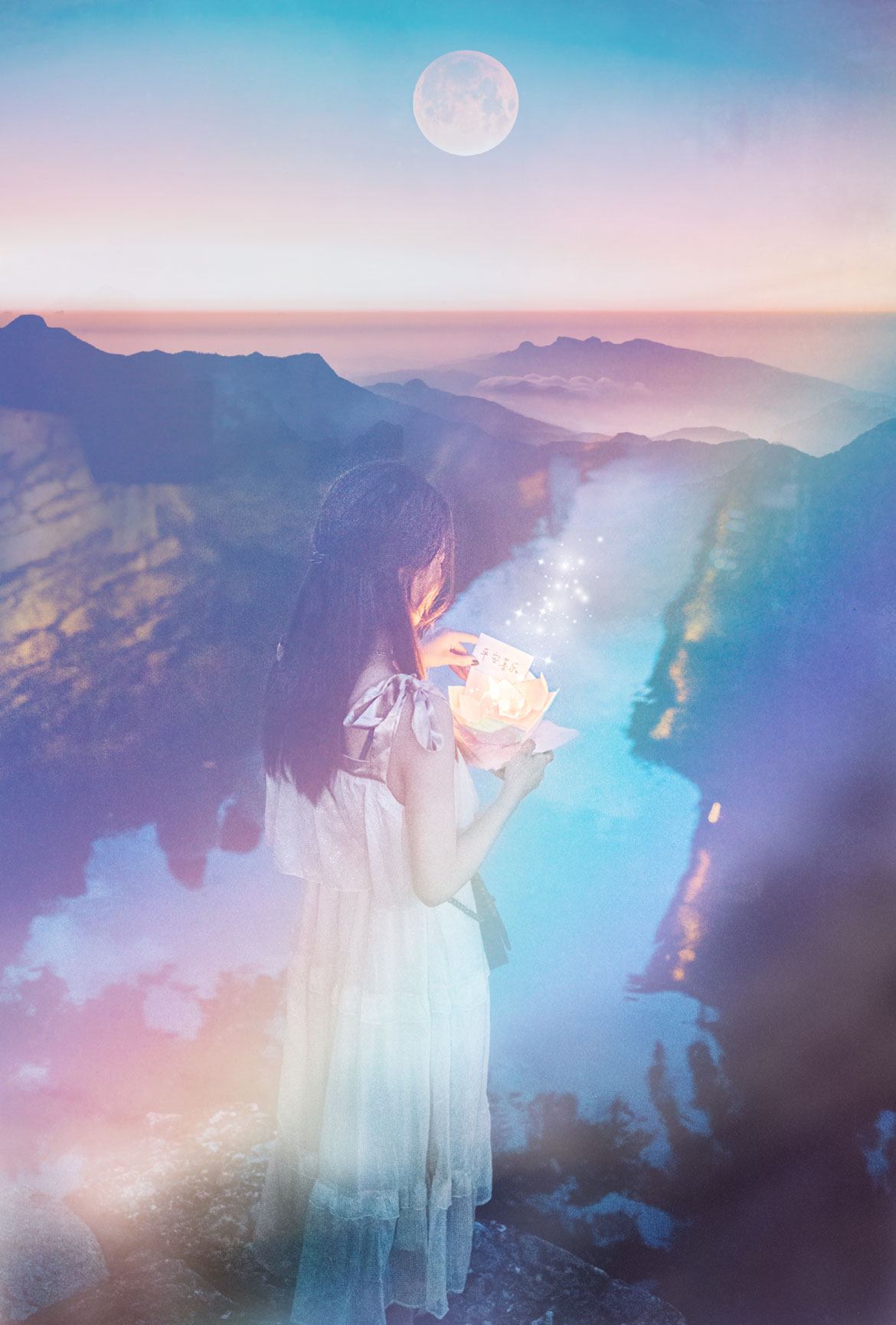
Each issue will invite you to explore your creative practice in whichever way works for you. Experience each issue at your own pace. Take what resonates with you and put the rest aside for another time.
Grab a cup of something lovely and dive in.
MONTHLY THEME
Art & Spirituality: The Soulful Connection
You may or may not realize it yet but when you step onto the artist’s path, you are being guided to connect with your soul. You may be most concerned with your materials or making that face look like a face or following the steps laid out in a lesson but simultaneously, in a quiet stirring just below the surface, you are being drawn closer to the essence of who you are. You see, Art and Spirituality go hand in hand. Whatever your beliefs, upbringing, culture, age or experience level, Art is inviting you to go deeper.
“Creativity is the voice of the spirit. One’s art should be the extension of oneself.”
– Maritza Burgos
Art and Spirituality
We may think of Art & Spirituality as two separate paths but they’re actually two strands that weave into one incredibly strong fabric. This woven tapestry can cover all in our life and enrich our experiences while here on the planet. As a duality, Art & Spirituality could be referred to as the Heart & Soul. The heart seeks out joy, love and compassion while the Soul draws us inside and connects us to the oneness of our existence. Add Art to the mix and you’ve got a potent tool to unite the two.
One of the most beautiful aspects of yoking our art and our spirit together is that it bolsters us as we learn. For example, when you are struggling with a drawing that you just can’t quite seem to get right, you can be comforted that you are truly on a journey of discovery, you can choose to be compassionate with yourself. You can appreciate the process, not only the end result.
Art is SO, SO much more than creating a “good painting” or an “accurate drawing”. We all can relate to how frustrating it can be to hone your skills. We can all attest to the hard work and devotion it takes to improve, yet we can be nourished by the knowledge that your Art is an invitation to understand yourself and your world on a deeper level. Understanding that in many intangible and subtle ways, Art is opening us, encouraging us to unfurl in ways other pursuits may not. I truly believe that this is why creativity is so important for everyone! Creativity is our connection to the divine and our gateway to spiritual expansion.
“Sticking with that uncertainty, getting the knack of relaxing in the midst of chaos, learning not to panic – this is the spiritual path.”
– Pema Chodron
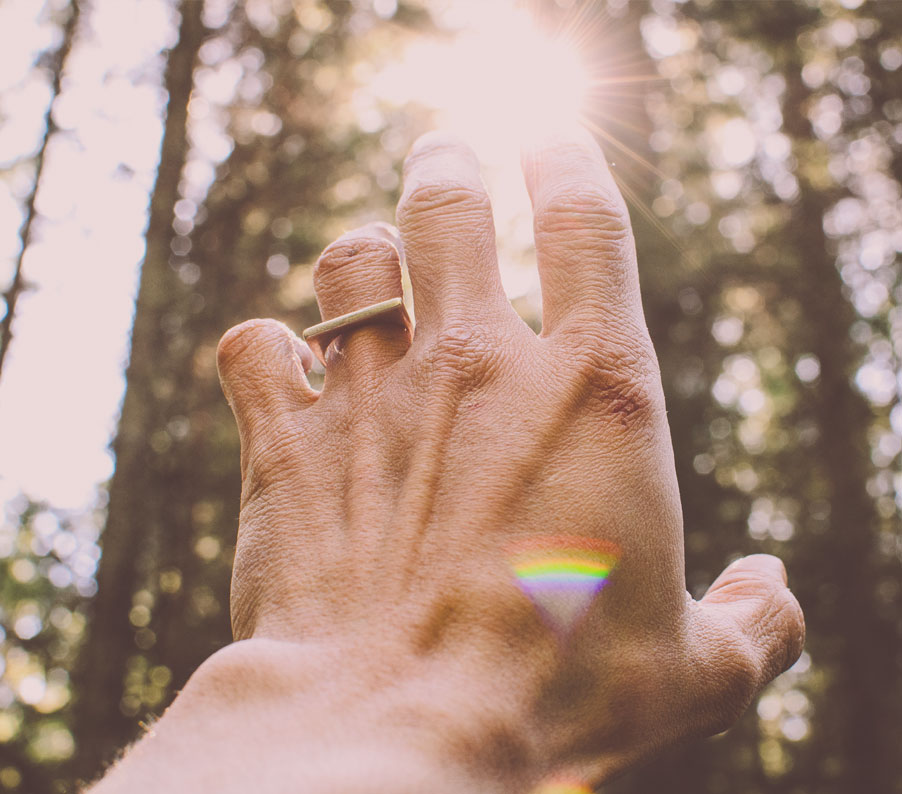
The Artist’s Soul
Let’s explore our Artist’s Soul – what makes it tick, what does it yearn for? While this will be a bit different for everyone, there is a universal kinship that I have witnessed over and over again when in community with Artists. The Artist’s soul is hungry for meaning, mystery, stories, significance and discovery! She doesn’t accept the mundane or the trivial.
The artist is living and breathing the soul of her craft. She takes each day (or as often as she can) as an opportunity to be still, feel the energy of life, listen to what it tells her and make her artistic statement. The artist is curious about everything around her; from colors to sounds to patterns to that strange, old abandoned house on the corner.
There is so much MORE to EVERYTHING in life and this intensity, this love, this devotion sustains her. This inner fire helps her burn through fear, uncertainty and feelings of unworthiness. Like a phoenix, she can rise from the ashes of her ruins, again and again. I have witnessed this collective resilience among Artists right here in our community! Even when times are challenging or something doesn’t go as expected, the Artist (eventually) returns to her work and in turn, her work often shifts and exhibits the effects of her trials.
The Artist’s soul is most importantly, hopeful. There is always possibility, potential. Something waiting to emerge. Something stirring in the darkness. Embrace your beautiful, sensitive and powerful Artist’s Soul.
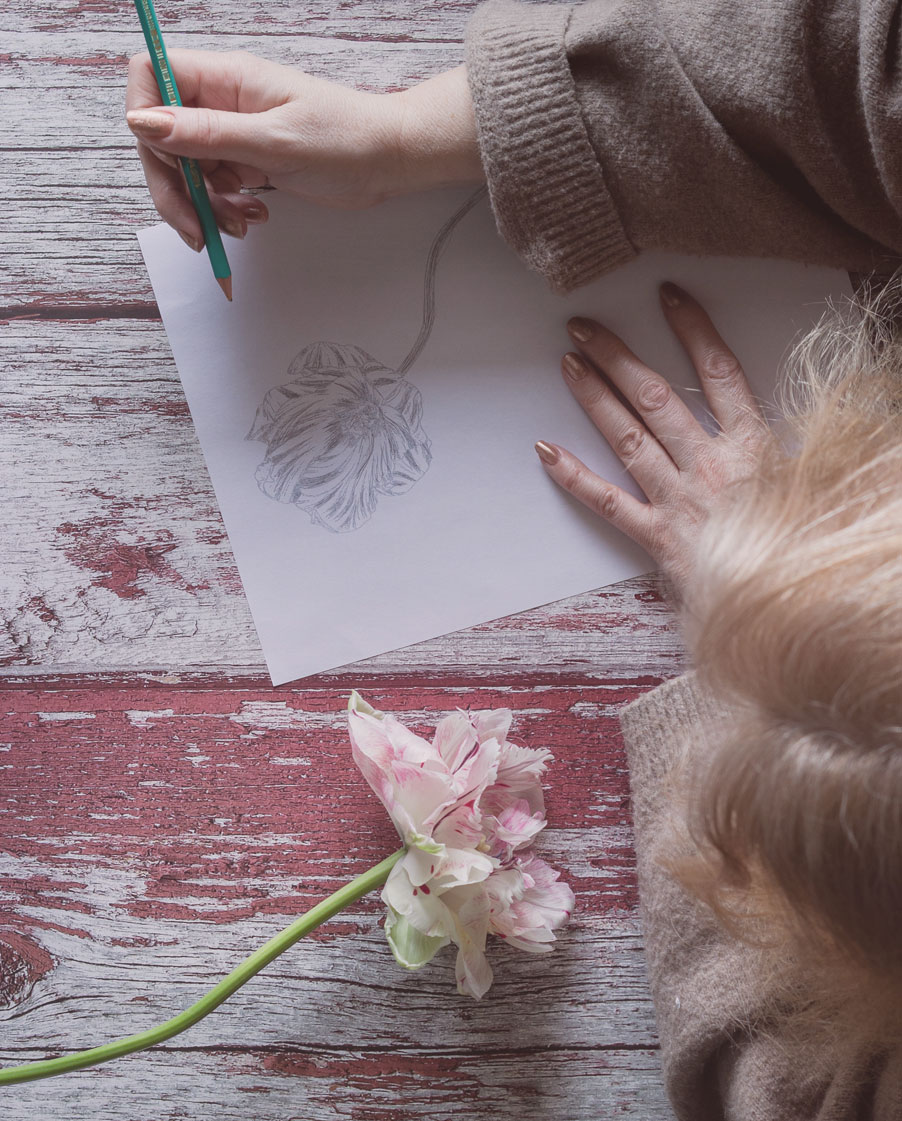
“Our place on Earth is to go deeper, to somehow get wiser. To have spirit.”
– Glen Hansard
Connecting with your Artist’s Soul
You have entered into an important spiritual journey. On your journey you will find your artist’s soul speak to you in many forms, at times it may be a whisper, other times the laughter of a young child, at times it may be a deep longing, wordless and urgent. Listen to these.
Here are three practical ways to deepen your connection with your inner artist.
1. Find moments of Stillness. Some may call this meditation but so often there is a resistance to this term. People may think they need to sit perfectly still and eradicate all thoughts from their minds and stay that way for long periods of time. No wonder there is resistance right? No. Try incremental changes, baby steps towards finding moments of stillness. It could be starting the morning with 5 minutes of deep breathing while still in bed. It could be sitting with your cup of morning coffee or tea and just watching the sky outside your window for a few minutes. It could be doing a 5 minutes doodle or quick sketch of a nearby object. Start there….then build up. It is in these quiet times that we hear our higher self, our Artist’s soul and you don’t want to miss out on what it has to say!
2. Spend time in Nature. Step away from the computer, put down your phone and step out into the natural world. Here you can find inspiration, peace, solitude and wisdom. As you will see when we get into our Master Artist, the natural world has so much to tell us, so much information to share. We only need to start paying more attention. So go for a walk in the woods, a stroll through the park and use your senses to connect to trees, the sky, the water, the wind…all of it. Slow down and take it in. If there were to be a very first responsibility of the Artist then it is to OBSERVE. LOOK. SEE. Be a witness to the world around you.
3. Journal. Many of you may already do this and if you are experiencing resistance to this practice approach it gently. Again, like with meditation or any practice begin slowly. Small steps toward a goal. Heap on the self-compassion and explore why you are resisting. A journaling practice can be very simple. It could be writing down 3 things you are grateful for each night or morning. It could be a sentence that describes how you feel or what happened that day or what the weather was like. There is no journaling competition to see who writes the most, who is the most eloquent, who has the best handwriting. So tell your Ego to relax.
These practices are for YOU. You and your inner Artist. You don’t need to share what you are doing with anyone, you don’t have to ask for permission, post it on Facebook or look for outside validation. In fact, I would invite you to keep these practices to yourself. Let them be your little juicy secret with yourself. Oftentimes when we share new things like this that we may be trying out, outsiders have little to add and may even derail you. So for now, if it feels good to you, keep your spiritual practices close to your heart. Let them evolve and expand as you do. Let them hold a sacred place that is just for YOU.
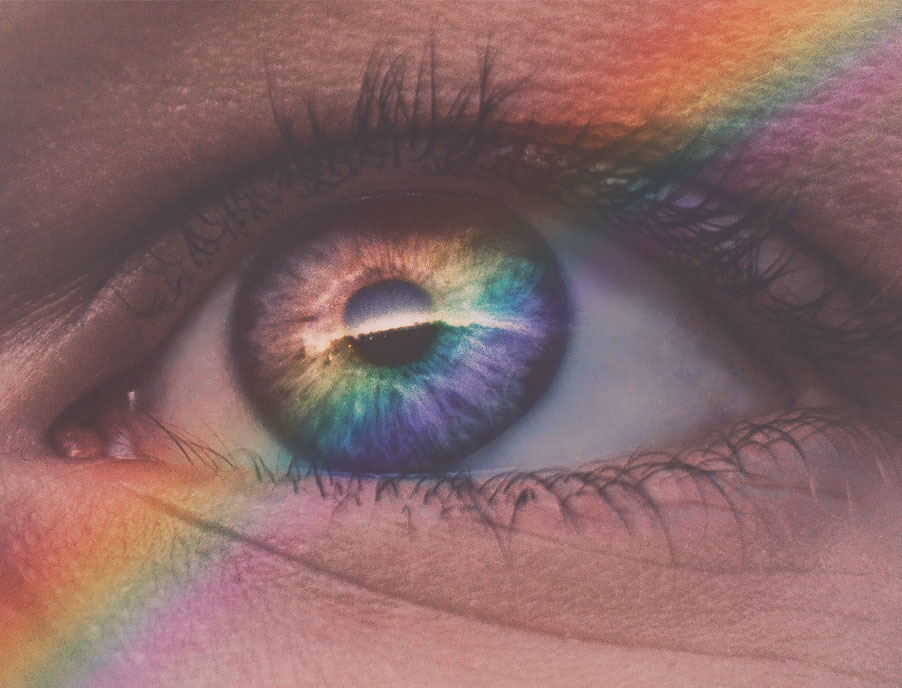
“Every man who steeps himself in the spiritual possibilities of his heart is a valuable helper in the building of the spiritual pyramid which will someday reach to heaven.”
– Wassily Kandinsky
Art & Spirituality: The Soulful Connection
An Artist’s Altar
“Be creative. Don`t be worried about what you are doing – one has to do many things – but do everything creatively, with devotion. Then your work becomes worship. Then whatsoever you do is a prayer. And whatsoever you do is an offering at the altar.”
– Rajneesh
When we hear the word altar many think of religious altars or a construct dedicated to worship and yes, that is one interpretation of an altar. I have another one – I believe an altar is a place to gather special objects. By intentionally gathering these objects, we can pay closer attention to them. We can commune with them, appreciate them and highlight them as symbols of importance in our lives. That’s why I think it especially potent for an Artist to consider incorporating an Artist’s altar into their creative space.
This altar may indeed incorporate religious objects that correlate with your faith but on the other hand your altar may be completely secular. It may be a simple candle and a postcard of a favorite artist or it may be an elaborate display of imagery and objects that are deemed sacred by you. It could be a collection of natures treasures that you have collected, shells, flowers, seeds, feathers. There is NO wrong way to create an Artist’s altar and it will be and should be a uniquely personal expression.
Why have this altar you may ask? Well, I believe it can serve as a reminder of our connection to our spiritual path as an Artist. It can elevate simple tools like your favorite brushes to a level of reverence. A reminder that reconnects us to the true nature of artistic practice. It can be a place to still yourself before you begin a new piece. A place to reset.
Your Artist’s altar can serve as a visual marker of your devotion to your art. It can provide an element of ritual in your creative practice. A ritual need not be some complicated series of actions but rather it can be simple. Lighting the same white candle before you begin to work. Playing a certain song or burning incense or sage. Saying a quiet prayer or affirmation. Rituals are calming for us and they can delineate a threshold. For example, going from a busy day at work to stepping into your studio to create. A simple ritual can illuminate this transition and allow you to shift your energy with more ease.
MY ALTAR
My altar incorporates some of my favorite brushes, a feather, a few of my favorite crystals, a candle, a flower from my garden, some sage, a stick of palo santo and a sweet little statue of the Virgin Mary. For me, these objects are not only beautiful but they bring me back to a place that has nothing to do with the external world. When I spend time at my altar, everything fades into the background, my mind stills and my heart expands. I remind myself that I am merely a servant to my art and that I humbly and openly invite in what is meant to come through my hands and onto the page. The ego is quiet. The external voices are quiet. Social media is irrelevant. It’s just me in communion with my Artist’s soul. Don’t deny yourself this sacred connection.
Objects that you might want to include on your Artist’s Altar –
- Natural objects, – leaves, shells, branches, rocks etc
- Crystals
- Candles
- Images of your own art or art you admire
- Incense burner
- Sage, Palo Santo or cedar
- Religious icons or symbols (if that aligns with you)
- Photographs of loved ones or ancestors
- Your favorite quotes or poems
- Your favorite brushes or tools
- Pieces of beautiful fabric or paper
- Cards from loved ones and friends
- Images of animals you connect with
- Sketches from your sketchbook
- Essential oils (you can dab these on and engage your sense of smell)
- Favorite tarot or oracle cards
- Books you like to pick up and read a quick page
- A small box where you can stash a written intention, wish or dream
- ANYTHING special to you!
“All nature is the temple; earth the altar.”
– Alphonse de Lamartine
An Artist’s Altar
I love this poem by Danna Faulds that beautifully reminds us how the devotion to our Artistic practice can bear gifts unseen, discoveries unexpected and so much more. It reminds us that the riches lie in the process, not the product.
The Fruits of Practice
Despite fervent pleas for ease
and safety, there are many days
when reality doesn’t quite line
up with what I’d choose.
Breakdown. Letting go.
Surrendering even the illusion
of control. Breathing into the
unknown – sometimes that is
what life holds.
Practice hasn’t brought an end
to pain. I still increase my
suffering like a fish caught on
a line. My struggles only draw
the hook in deeper. But being
in reality is its own reward.
It’s the perfect paradox; the
courage to stand and breathe
when everything in me wants
to flee is as great a gift as the
freedom to seek retreat.
No, practice hasn’t brought
an end to pain but it has honed
my willingness to experience
the moment and sometimes see
perfection unfolding in ways
I wasn’t big enough to plan,
much less predict.
Practice isn’t about achieving
a goal. It’s not a means to pole-
vault over suffering. Practice
is my way of looking life in
the face and saying yes to all
its disparate gifts.
Practice
keeps me awake when I would
sleep, and reminds me it’s
the journey, unfolding in this
very moment, it’s the journey
that reveals the truth, and
not the destination.
Check out some of Danna’s books here
The Fruits of Practice
CREATIVE INTUITION
with Elizabeth Cooper
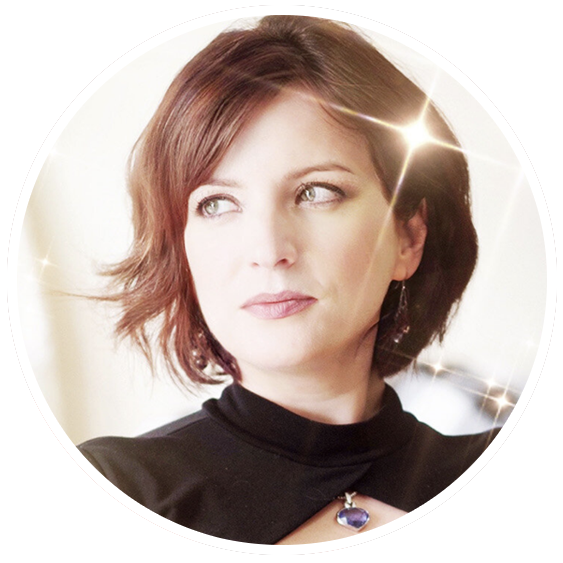
I’m excited to announce that my dear friend and fellow artist will be a regular contributor to the Studioworks Journal! She is my go-to when learning more about my intuition and integrating it into my creative practice. This month she’s got a beautiful guide on how we can use intentional rituals to energetically cleanse our creative space and our creative tools.
Energetically Cleanse Those Brushes
(and Canvases and Paints and…)
“Purifying the energy of your art supplies isn’t rocket science — hello, moonlight! — but these tips make it a breeze to get your tools vibrationally squeaky clean.”
Every piece of art you create begins with choosing your tools. Whether you’re sculpting, painting, and drawing, you can’t do any of it without handling, at the very least, the most basic of supplies. It doesn’t matter if you’re scratching in the dirt with a stick to create your masterpiece. The moment you focus your intent on expressing your creativity, the object in your hand becomes a sacred tool.
Like everything else in the Universe, our art supplies are composed of energetic vibrations. Quantum physicists agree. Einstein’s famous equation, E=MC^2, states that everything around us is simultaneously comprised of both energy and matter. This means you, too, of course. As well as your cat, the food you eat, the crystal on your window ledge and the canvas on your easel. We move through these energy fields automatically, unconsciously. We take no notice of them, but it doesn’t mean they’re not there.
If we made our art amid Mother Nature’s habitat, we wouldn’t need to worry about cleansing our tools. Earth herself would take care of it for us. Wind, dirt, and rain would dissipate the heaviness that can accumulate in a static space.
Over the years, I’ve learned that vibrationally cleansing my studio space and art supplies is as important as physically cleaning my home. I can feel the difference, and my art benefits from the fresh, clear energy I use to create the work.
Below you’ll find several methods you can use to approach this task. Read through all of them, and choose the one(s) that call to you the most.
The Smudge Method
Smudging is the ancient ceremonial practice of burning dried herbs (often sage, sandalwood or mugwort) to cleanse negative energy from a person or area.
- HOW TO DO IT: You can purchase loose herbs, and you may choose to light those in a fireproof bowl. I prefer buying ready-made smudge sticks from an Indigenous-owned business. These bundles are often created using a combination of herbs, such as sage, lavender, juniper, and mugwort.
Open all the windows and doors in your studio. Hold one end of the bundle and light the other end until it begins to smoke. Let it smoulder for a few seconds, then blow it out, so only the smoke remains. Wave the smudge stick around your studio and over any tools you’d like to cleanse. Allow the smoke to circulate from the top of your head to your toes. Spend a little extra time in the corners of the room and any dark places (shelves, drawers, closets) where stagnant energy tends to accumulate.
- APPROXIMATE DURATION: 10 minutes
- USE THIS FOR: Any tools, supplies, or spaces – as well as yourself.
- BEWARE OF: Cultural appropriation. This type of cleansing ritual and the plants used to perform it are considered sacred medicine to Native American / Indigenous Nations. If you are not native, please be respectful and aim to fully understand the history of this practice and its significance before you incorporate it into your routine. Avoid purchasing smudge sticks from mass retailers, and choose instead to support Indigenous-owned businesses.
The Sound Method
Many spiritual practitioners believe that sound vibration is among the quickest and most effective ways to cleanse energy from a space, an object, or a person. Moreover, the right frequency doesn’t just purify but also restores the energetic harmony naturally occurring in the physical matter.
Because sound penetrates molecular structure so effectively, this method is handy for cleansing large, dense items like canvases, easels, and your art table.
- HOW TO DO IT: You can play recorded music. However, the energy of sound waves is most potent when the sound is created in the presence of the items being cleansed.
You can use various instruments, from singing bowls to bells, chimes, a tuning fork, a piano, a violin, a flute, or even your own voice chanting a mantra.
Visualize the sound as it cascades over your supplies and then expands outward to encompass the space you’re in. Imagine all the objects around you releasing old, stagnant energy. Let those vibrations be carried off on the sound waves.
- APPROXIMAGE DURATION: 10 minutes.
- USE THIS FOR: Any tools, supplies, or spaces – as well as yourself.
- BEWARE OF: The instruments’ quality, especially if you’re using something like a singing bowl or a tuning fork, where the sound emanates for some time and then gradually fades. Poor quality instruments resonate with a dull, metallic hum and are less effective at cleansing your tools.
The Moonlight Method
Moonlight is one of the oldest methods of cleansing energy. It’s safe, easy and available anywhere. Although its potency is most substantial during the full moon, you can do this any time of the lunar cycle. And you don’t even need to see the moon to benefit from its cleansing properties. Moonbeams easily penetrate cloud cover to reach the objects you’d like to cleanse.
- HOW TO DO IT: Place your items in direct view of the moon. A windowsill works well, or a table set in front of a large window. Leave them there overnight. In the morning, they’ll be refreshed and energetically ready for use.
- APPROXIMAGE DURATION: A minimum of 4 hours, but preferably overnight.
- USE THIS FOR: Small art supplies and spiritual tools.
- BEWARE OF: Choosing to set your items outside. Placing your supplies in contact with the earth adds power to the cleansing ritual, but you’ll want to make sure your items won’t be disturbed by wildlife or a random passerby. You’ll also want to be certain that morning dew or unexpected weather formations won’t ruin your supplies.
The Essential Oil Method
The use of essential oils has risen dramatically in the past few years. Not only can oils help with a wide variety of psychological and physical ailments, but many oils also have exceptional cleansing and purifying properties.
Scents such as white sage, cedarwood, citrus, peppermint, frankincense, and juniper berry are best for this type of energy cleansing.
- HOW TO DO IT: Although you can use oils in various ways, I prefer diffusing the scent throughout my studio. I set up a diffuser next to my easel, so the mist can permeate any art supplies I’m using for that particular piece. You can also move the diffuser around your space so the mist can reach multiple areas.To do this, you’ll need a diffuser (these come in various sizes and price ranges), a few drops of essential oil, and water.If you don’t have a diffuser, a great alternative is creating a DIY essential oil spray to spritz around your studio. I recommend searching online to find the right mix of ingredients.
- APPROXIMAGE DURATION: A few hours at a time.
- USE THIS FOR: Your studio space.
- BEWARE OF: The quality of the oil. As with all other ingredients you bring into your home, you’ll want to consider investing a little more in the purest options. Not all oils are created equal. You’ll also want to check warning labels. Some oils aren’t suitable for pets or young children.
The Rice Method
This is an excellent method for pulling out unwanted energy and withdrawing it in a safe and contained way.
- HOW TO DO IT: Grab a large bowl — preferably transparent — and fill it, about halfway, with rice. I prefer brown rice, but any type of rice will do. (Some of my clients have told me white rice feels energetically lighter to them and that they’ve had better results after using it in a cleansing ritual. So follow your intuition on this one.) Bury your items in the rice and let the bowl sit for 24 hours. Retrieve your items and then dispose of the rice as it now contains the unwanted energy from your supplies.
- APPROXIMAGE DURATION: one complete 24-hour cycle.
- USE THIS FOR: Small art supplies and spiritual tools.
- BEWARE OF: Using rice that’s been genetically modified (GMO).GMO foods have had their energy altered and won’t be as capable of removing negative energetic vibrations from your items. If possible, I recommend using rice that’s closest to its natural state, farmed sustainably, and ethically sourced.
The Breathwork Method
Your breath can be a terrific cleansing method. Like moonlight, it’s quick, easy, and available no matter where you are.
- HOW TO DO IT: Hold the item in your dominant hand. Focus your intention on cleansing stagnant, heavy, and negative energy. While you’re doing that, take a deep breath through your nostrils until you fill your lungs. Then, bring the item close to your face and release short, powerful gusts through the nose directly onto whatever it is you’re holding.
- APPROXIMAGE DURATION: 30 seconds per item.
- USE THIS FOR: Small art supplies and spiritual tools.
The more often you use your art supplies, the more energy they’ll collect. A solid guideline to follow is to clear your space and items once a month. However, if something feels heavier than usual, or if your own energy responds negatively to a specific tool, go ahead and cleanse it. There’s no need to wait any particular length of time between energy clearings.
Elizabeth Cooper is an artist and holistic coach specializing in helping frustrated creatives identify, develop and showcase their signature body of work. Learn more about her via her website: www.flutterandsprout.com
“Intuition is recognizing our higher path; creativity is what happens when we follow it.”
– Kim Chestney
Sacred Artist PROMPT:
- As discussed, consider creating an Artist’s altar in your home or studio, wherever you make your art. Follow your intuition and create a display that feels right to you. Then use the altar daily to honor the special connection you have to your creative practice.
WORD OF THE MONTH
Spirituality
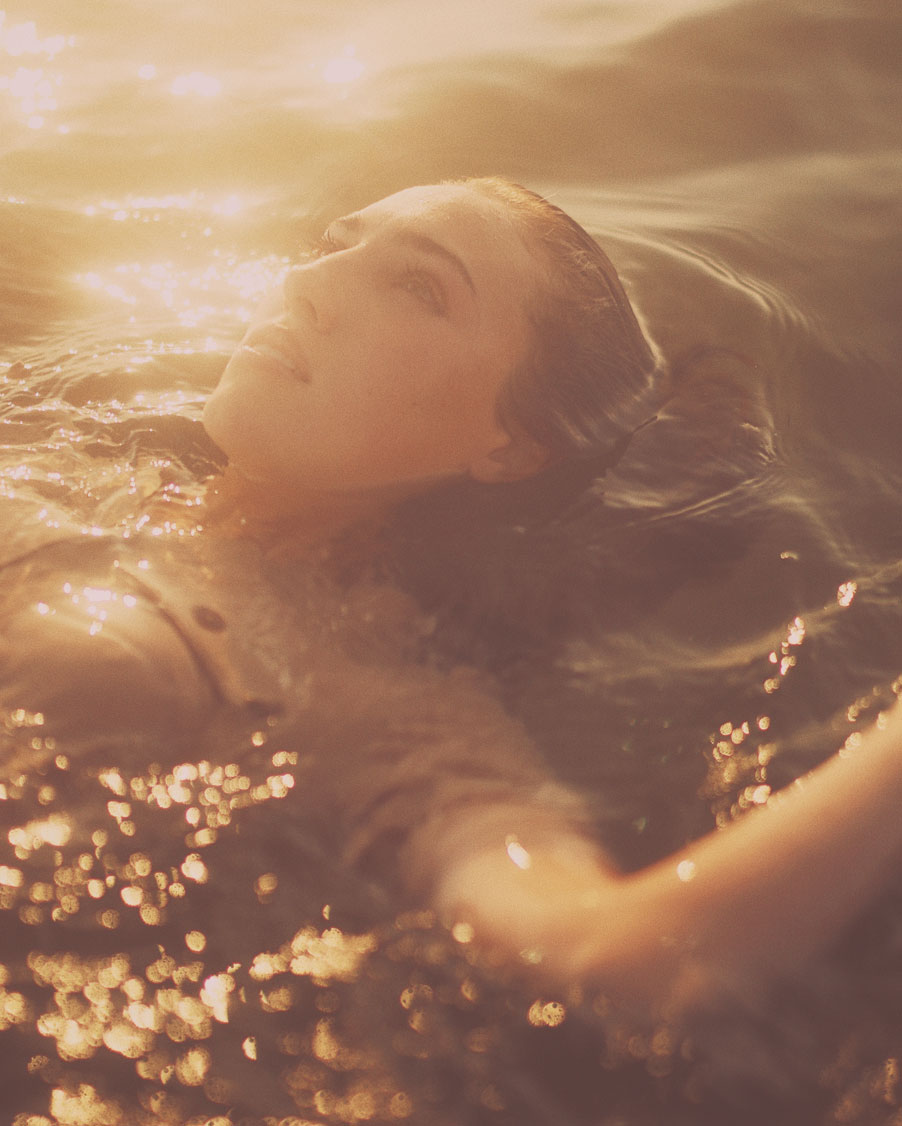
DEFINITION – SPIRITUALITY
noun – the quality of being concerned with the human spirit or soul as opposed to material or physical things.
“Spirituality involves the recognition of a feeling or sense or belief that there is something greater than myself, something more to being human than sensory experience, and that the greater whole of which we are part is cosmic or divine in nature. … An opening of the heart is an essential aspect of true spirituality.
Spirituality means knowing that our lives have significance in a context beyond a mundane everyday existence at the level of biological needs that drive selfishness and aggression. It means knowing that we are a significant part of a purposeful unfolding of Life in our universe.
Spirituality involves exploring certain universal themes – love, compassion, altruism, life after death, wisdom and truth, with the knowledge that some people such as saints or enlightened individuals have achieved and manifested higher levels of development than the ordinary person. Aspiring to manifest the attributes of such inspirational examples often becomes an important part of the journey through life for spiritually inclined people.”
– Dr. Maya Spencer
(A common question asked – What’s the difference between religion and spirituality? … Religion is a specific set of organized beliefs and practices, usually shared by a community or group. Spirituality is more of an individual practice and has to do with having a sense of peace and purpose.)
“Art is not an end in itself. It introduces the soul into a higher spiritual order, which it expresses and in some sense explains.”
– Thomas Merton
Word of the Month - Spirituality
Journal Prompts & Card Spread
We usually have a writing prompt as I think it is so important to truly reflect on our artist’s journey and document our process, emotions and progress. This month, I’ve chosen to add a suggested Card Spread for those of us who enjoy using Tarot or Oracle cards as a means of connecting with our intuition. These tools have been a part of my creative path since I was a teenager, so I’m excited to further incorporate these aspects into our community. Remember that this isn’t about forecasting the future but rather connecting with your higher self and the wisdom of your intuition.
If you are not one who uses Tarot or Oracle cards, no worries! Just use the writing prompts as starting points in your journaling. I always like to simply write the question at the top of the page and then just “free write” – which involves simply letting ANYTHING that comes up to flow onto the page. Even if it doesn’t make sense at first. If you find writing challenging you can also do this in list form. Just let it go and don’t overthink.
As always, take some quiet time to do this. It can be helpful to do a short meditation or just get still and take some deep breaths to ground yourself into the present moment. Never judge or criticize what arises. Always be self compassionate and open in this process. Our intuition has such great wisdom for us, we just need to be willing to listen…
How can I better connect with my Spirituality?
What is blocking me from connecting with my Artist’s Soul?
How will connecting deeper to myself and my Spirituality help my art?
See the card spread PDF to do your own reading.
Journal Prompts & Card Spread
Light Activation Meditation
WITH RACHEL HILLARY
This powerful meditation connects us back to the light within. Give yourself the gift of 20 minutes to enjoy this beautiful journey. I’ll let one of my favorite meditation creators, Rachel Hillary, share a little about this experience –
This meditation is guided by my voice for 15 minutes, then is just music to sit with the energies for the last 5 minutes. It is designed to pull light energy from the top and bottom of your physical body, using this light for healing, activating, and awakening to who you really are as a divine being. Connecting us back to this magic all around us, it’s a daily practice I do myself and I love to do.
xo,
Rachel
Light Activation Meditation
You can download more meditations and connect with Rachel here…
“We are not separated from spirit, we are in it.”
– Plotinus
Monthly Affirmation
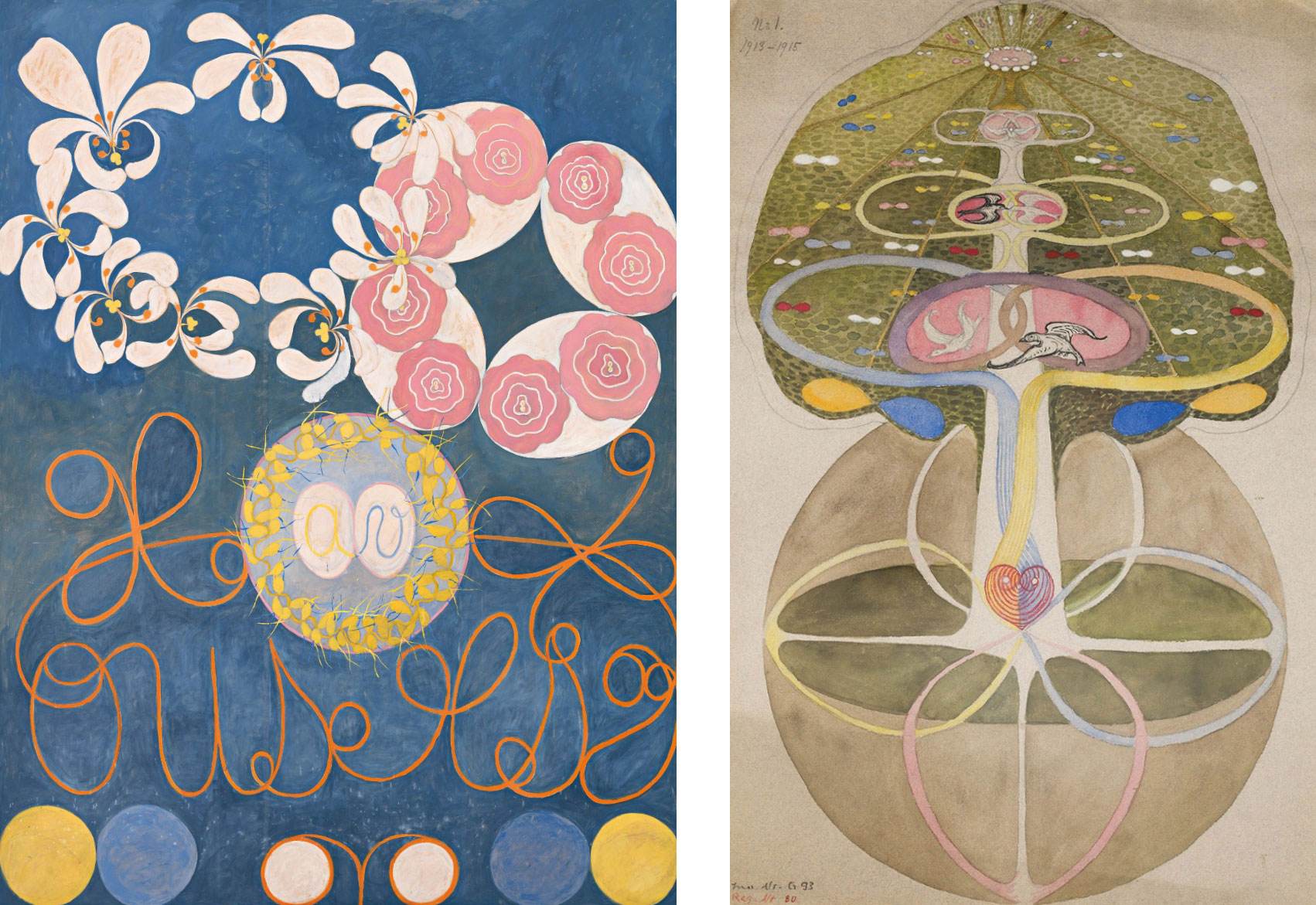
Color Palette of the Month
This month, I couldn’t help but be inspired by our Master Artist – Hilma af Klint. Hilma used color with great intention and purpose. As a spiritualist artist each mark, symbol, shape and of course, color held great meaning. Yellow was masculine. Blue, feminine. Green is the merging of these energies. Pink symbolized spiritual love and red – passion or physical love. I am drawn to her use of a soft rainbow like palette but her color usage varies, often incorporating soothing lavender paired with robust orange. I’m going to focus on her softer colors as they call to my Artist’s soul but as always, if you are called to explore a different palette, please feel free.

“The soul becomes dyed with the color of its thoughts.”
– Marcus Aurelius
Color Palette
Sacred Artist PROMPT:
- Spend some time considering what symbols you use in your artwork. What do they mean to you? What are you trying to convey when you use them.
Master Artist Guide
Hilma af Klint
This month I’m so very excited to bring you the work and story of Hilma af Klint. This artist was not one I learned about in Art School, in fact she only very recently came onto my radar – ironically, when I went to research another master artist – Wassily Kandinsky.
Ironic because Kandinsky crowned himself the first purely Abstract artist back in 1911 when one of his watercolor paintings was exhibited in Munich. Little did Kandinsky know that years earlier in 1906, a young Swedish artist began privately creating large, purely abstract paintings. The likes of which the modern world would not see on display until 1986 in Los Angeles at the Los Angeles County Museum of Art! Hilma af Klint’s abstract works predate Kandinsky and have caused quite a stir among the Art Historians and academics alike! How could I resist not looking deeper into this tale?
So while I was going to first teach about Kandinsky this month, I couldn’t pass up an opportunity to shine light on this incredibly inspiring woman artist! Kandinsky will have to wait. She was also a part of the Spiritualist movement so she fits perfectly into our theme.
(One word of advice when looking at her artwork, let your soul see it, don’t just use your eyes and your mind. Look at her work with your heart. You may be surprised at how a thread of recognition is found. Your mind may not be able to categorize or understand some of her art but your soul knows that not all need be named.)
Let’s learn more about her…
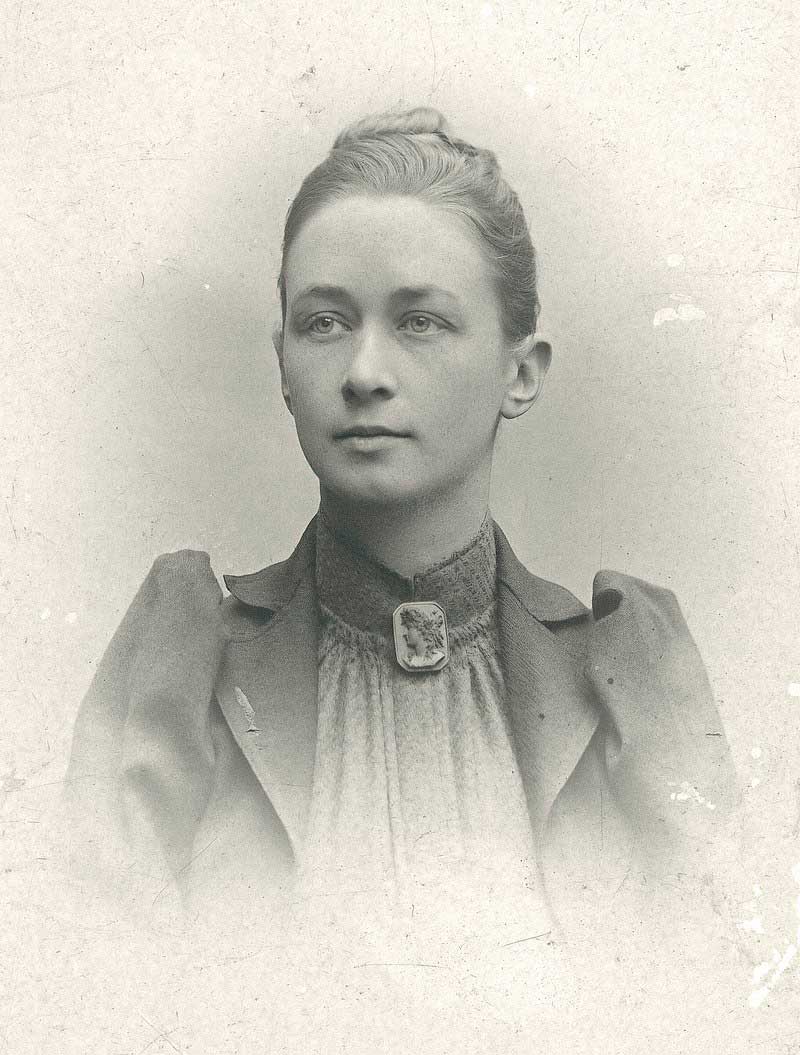
“You must learn how to ignore your fear, for without the will to believe in yourself, nothing good will happen.”
– Hilma af Klint
OVERVIEW – Hilma af Klint was born October 26, 1862 – and passed on October 21, 1944. She was a Swedish artist and mystic whose paintings were the first Western abstract art known to the current art community. A considerable body of her abstract work predates the first purely abstract compositions by Kandinsky. She belonged to a group called “The Five”, a circle of women inspired by Theosophy who shared a belief in the importance of trying to contact the so-called “High Masters”—often by way of séances. Her paintings, which sometimes resemble diagrams, were a visual representation of complex spiritual ideas.
childhood
Hilma af Klint was born in 1862, in Solna, Sweden, as the fourth of five children of a Protestant couple, Mathilda af Klint and Victor af Klint who was an admiral and a mathematician. Most of her childhood was spent in Karlberg castle, the naval academy where her father was based. During the summer, the family would move to Hanmora, in Adelso, an island in Lake Malaren, where Hilma’s fascination with nature and organic life began.
Little else is known about af Klint’s childhood and her relationships with family and friends. It is known that she was close to her mother and lived with her not only in childhood but also after her father died in 1898, until her mother’s own death in 1920. It seems that she was devoted to her work (both her art and her studies) and to her immediate family. One may speculate that there was no time for romance or too much excitement when following a life of devotion as serious as that of af Klint’s. However, this is an artist who kept 1,000 paintings secret for a very long time so one cannot help but wonder what else the world does not know about af Klint; her mystery has become her allure.
Education and Early training
Hilma first attended the Technical School, which is now known as Konstfack, studying classical portraiture under the supervision of Kerstin Cardon. During this time, the artist already had strong leanings towards matters of the spiritual and the occult. These interests grew rapidly following the death of her ten year old sister, Hermina when af Klint was just eighteen years old. It was at this time that she first began attending séances, mystical group meetings that aimed to create a dialogue with the spirit world. At the age of twenty, in 1882, she went to study at the Royal Academy of Arts in Stockholm. She remained at the Academy for a subsequent 5 years, continuing her classical art training.
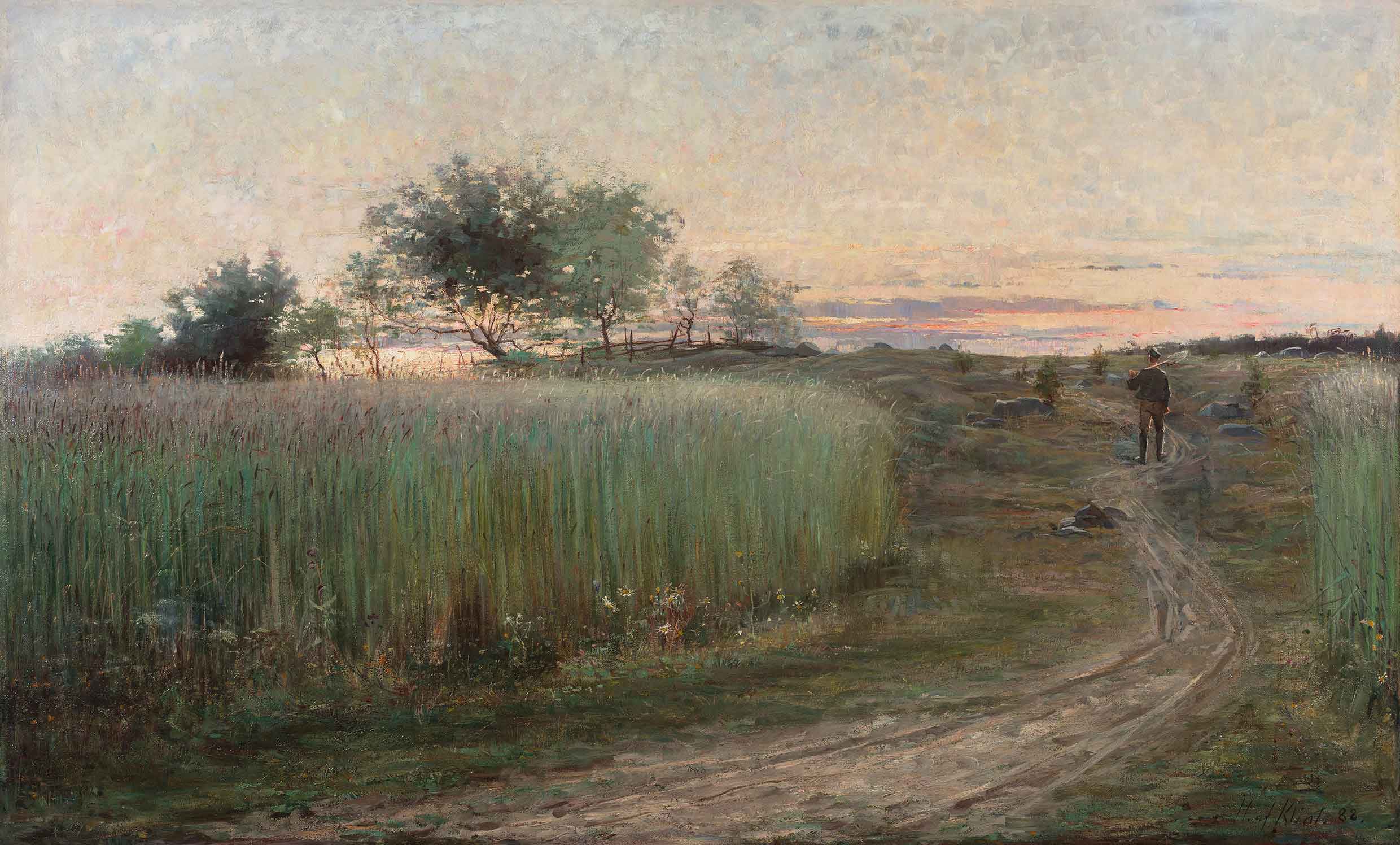
Summer Landscape, 1888
After graduating with honors, she was awarded a scholarship in the form of an art studio in Stockholm’s artist quarter, where her landscapes and portraits quickly became the source of her financial independence and stability. Luckily, the Scandinavian education system already admitted both men and women to their Academies (unlike France and Germany) and it was not uncommon for women to make a living from their art. It was, of course, more unusual for women to become visionaries and to surpass the talents of their male contemporaries.
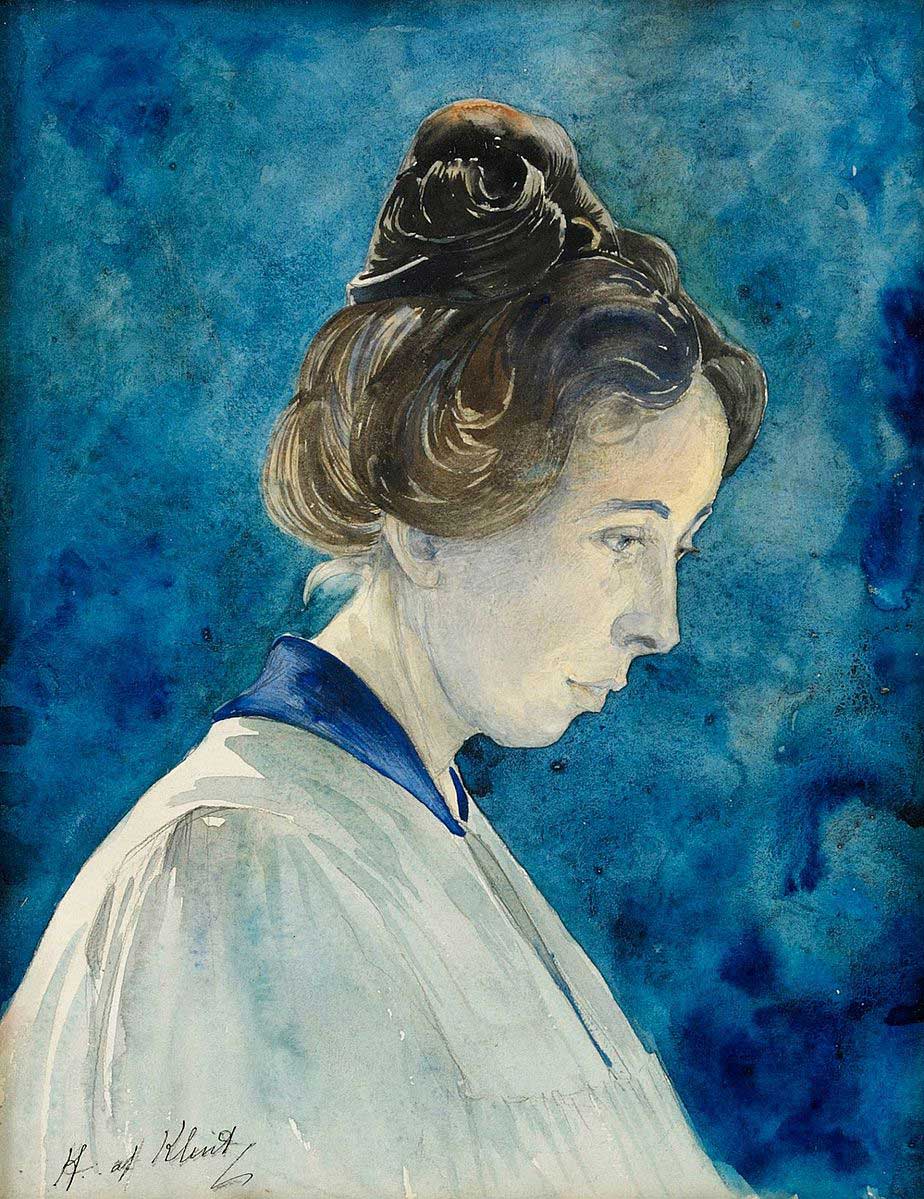
Self Portrait, date unknown
In 1896, with four female artist friends, af Klint established The Five (de Fem). The group conducted séances every week until 1906, experimenting with free-flowing writing and drawing, and with other spontaneous, unplanned ways of creating which aimed to allow for a more intuitive and direct way of making art. They opened each meeting with a prayer, followed by a meditation, a Christian sermon, and a review and analysis of a text from the New Testament. This would be followed by a séance. They recorded in a book a completely new system of mystical thought, in the form of messages from higher spirits called The High Masters. One of these Spirit guides, Gregor, announced, “All the knowledge that is not of the senses, not of the intellect, not of the heart but is the property that exclusively belongs to the deepest aspect of your being…the knowledge of your spirit”.
Critic Kate Kellaway, explains that these experiences “predated the surrealists by decades”, who were known to acquire much of their ideas and inspiration through a spiritual process.
In this way, privately and secretly, Hilma turned to unearthing, and furthermore understanding the unconscious as her motivation to make art. Paradoxically but also most appropriately, these abstract pursuits were rooted in a desire to understand the visible world around her in profound detail.
“The more we discover the wonders of nature, the more we become aware of ourselves.”
– Hilma af Klint
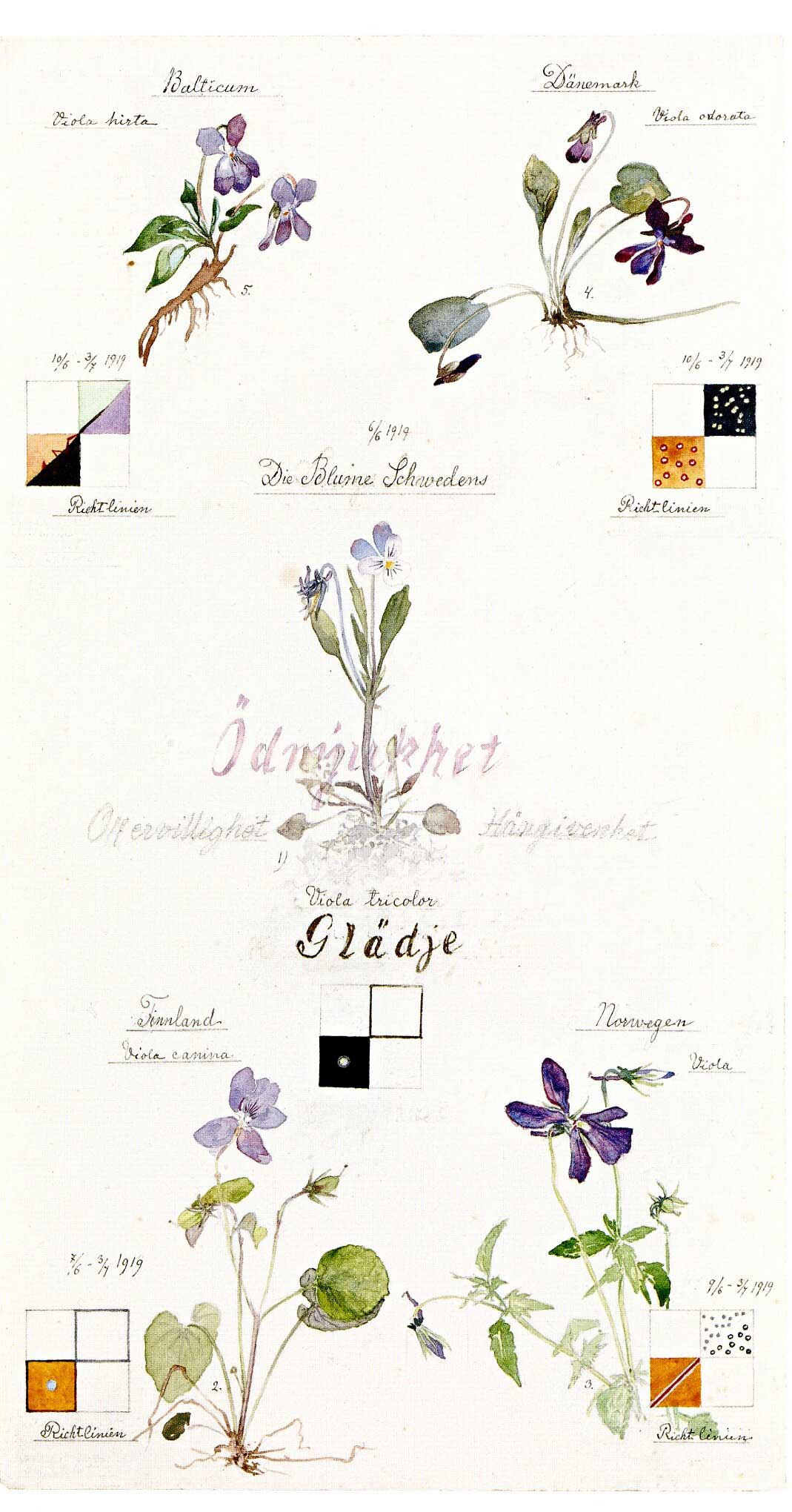
botanical study 1
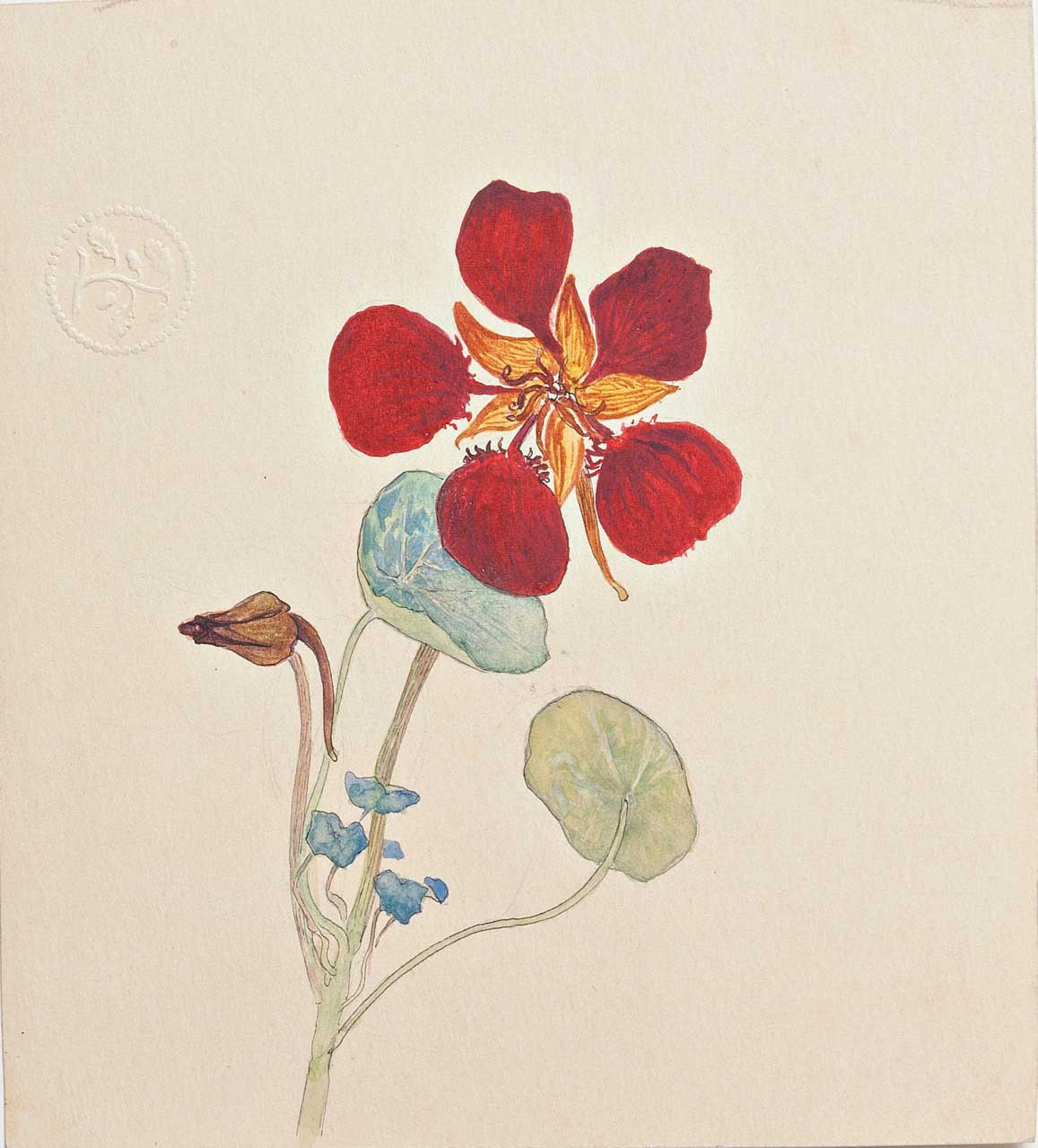
botanical study 2
Indeed, she also began to study plants especially from works conducted by the Swedish botanist Linnaeus, and animals, having worked as a draughtsman for a veterinary institute in 1900. Simultaneously, her profound fascination with the invisible world continued (an interest which was echoed by scientific discoveries of the day with the invention of the X-ray machine, electromagnetic waves, and telegraphy) as well as her affinity with spiritual theories being developed across Europe, especially Theosophy, founded by the Russian philosopher, Madame Blavatsky, and Anthroposophy. Anthroposophy was a spiritual movement developed by the Austrian philosopher Rudolf Steiner, which aimed to define a ‘spiritual science’, deeply rooted in Steiner’s ideas that spirituality could be rationally understood through both science and art.
Mature Period
Af Klint, who was small in height, with blue eyes, usually wore black and was vegetarian, was profoundly changed following an otherworldly experience in 1904. During a séance, she heard a voice telling her to make paintings ‘on an astral plane’ in order to ‘proclaim a new philosophy of life’. This was essentially a celestial commission, “from an entity named Amaliel who told her to paint the ‘immortal aspects of man”. Henceforth, from 1906 at age 44, af Klint embarked on her most prolific phase of abstract painting. Culminating in 1915, she had produced 193 works, each of which belonged to one of six series all over-arched by the larger body called Paintings for the Temple. She refers to this intensely creative period and process as being guided by a ‘force’, driven by a ‘higher power’ in a sort of ‘divine dictation’.
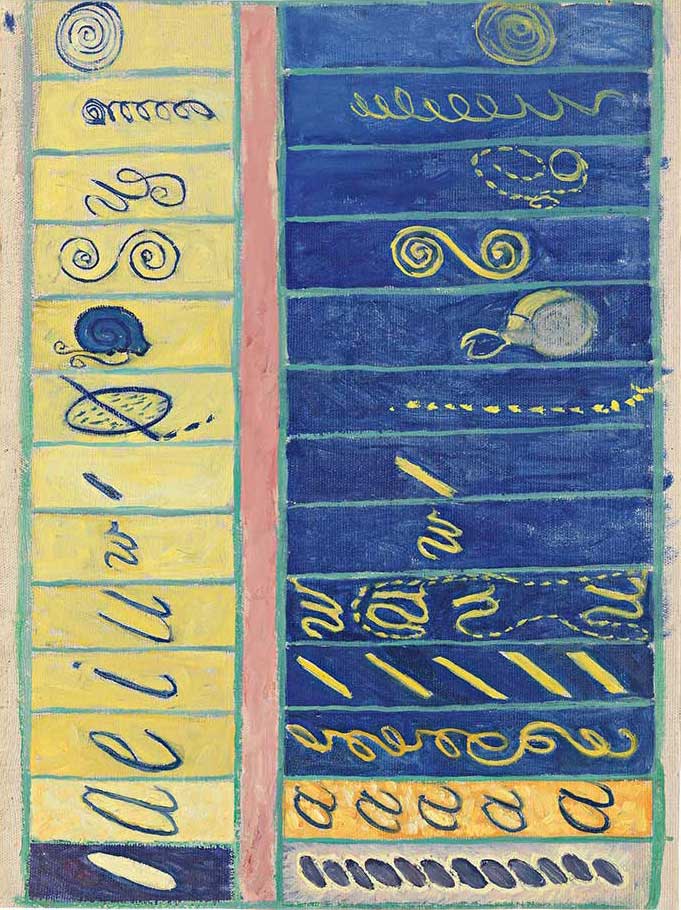
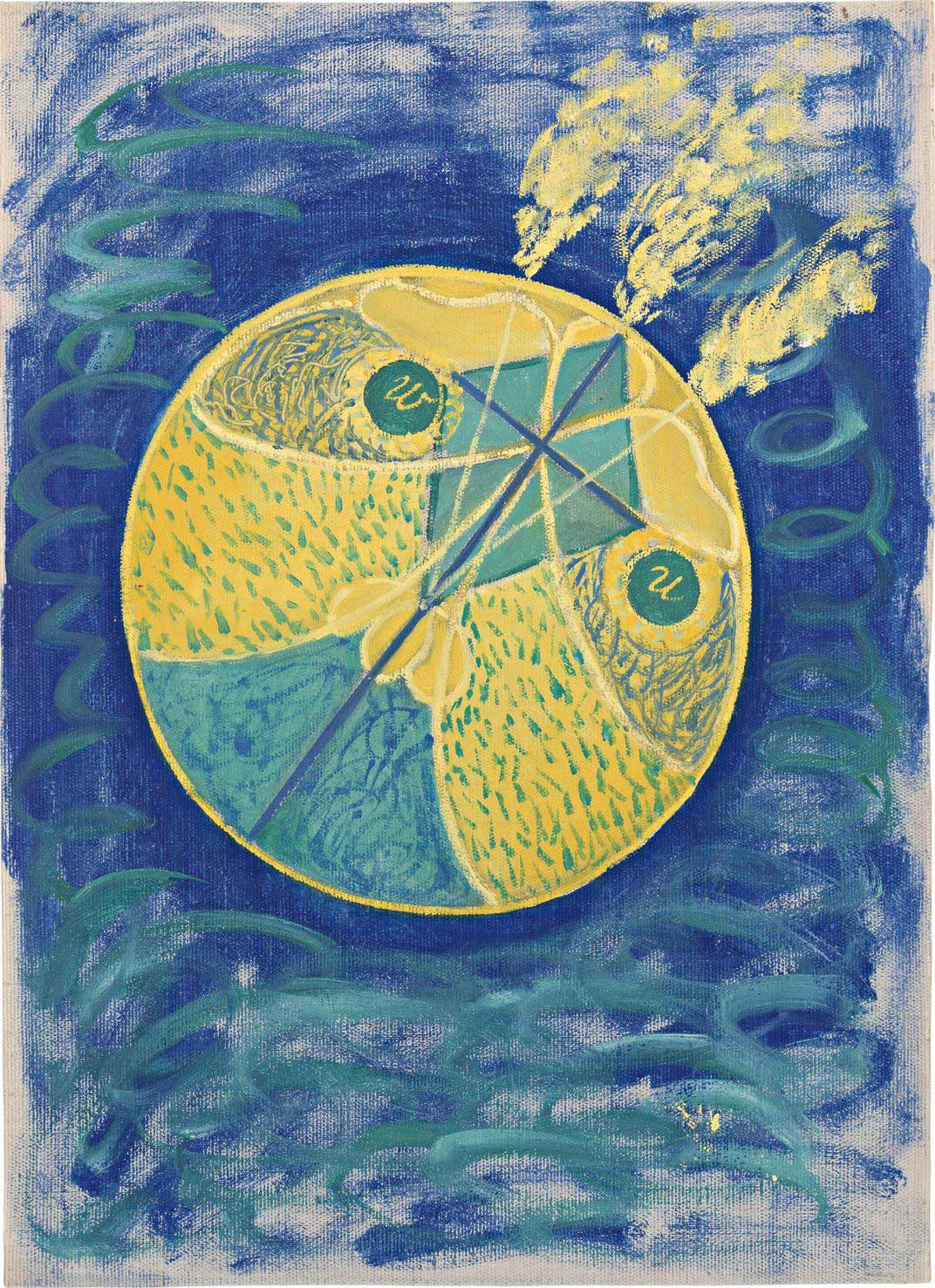
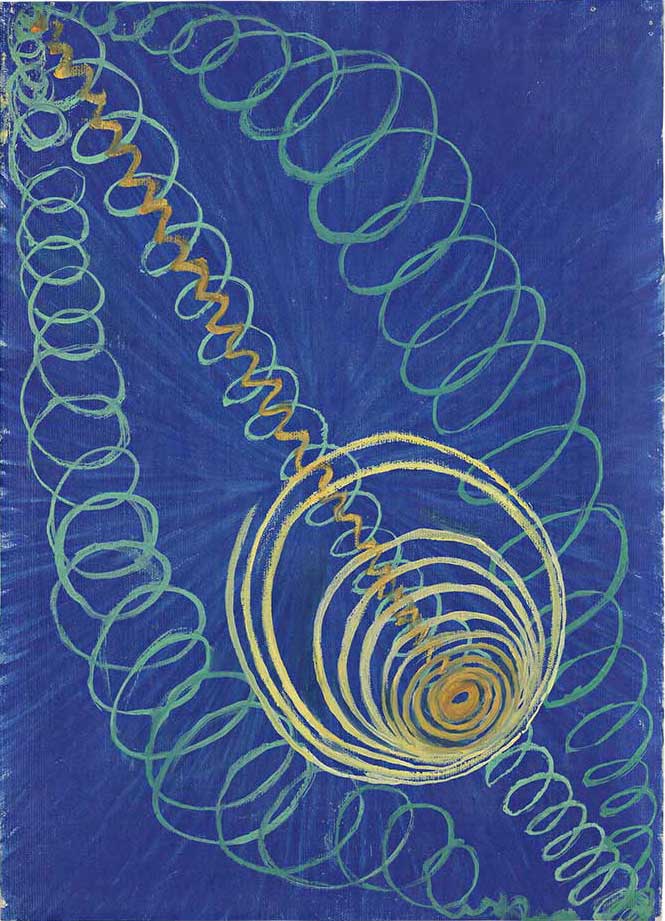
Three pieces from The Primordial Chaos Series 1906
“The pictures were painted directly through me, without any preliminary drawings, and with great force. I had no idea what the paintings were supposed to depict; nevertheless I worked swiftly and surely, without changing a single brush stroke.”
– Hilma af Klint
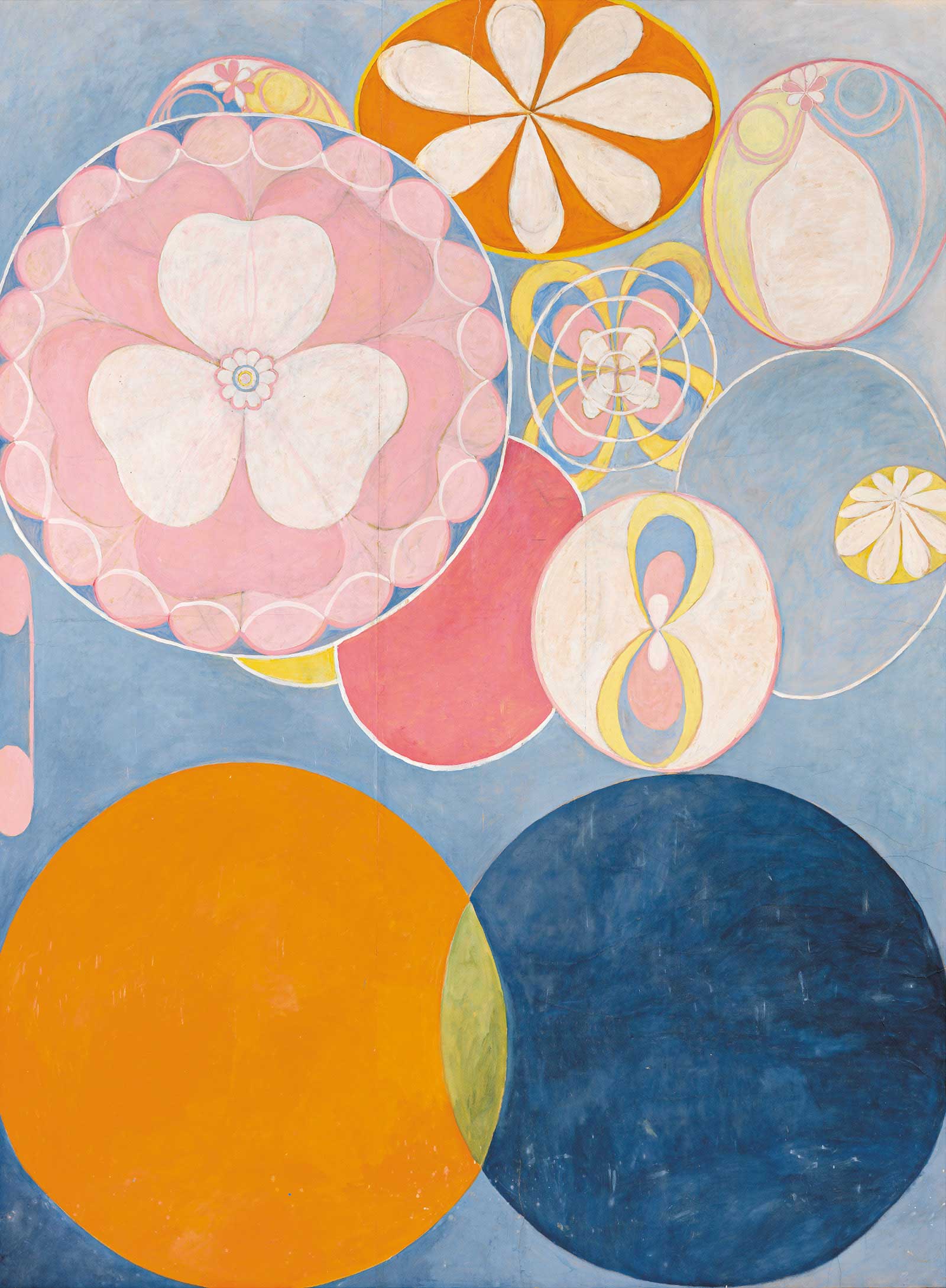
The Ten Largest, No. 2, Childhood, 1907
This continuous creative process was only interrupted between 1908 and 1912, during which time she studied widely and took constant care of her mother, who had recently become blind. At some point during 1908, af Klint invited Rudolf Steiner, who was lecturing in Stockholm, to see her work hoping that he would be impressed (for she in turn was a great admirer of his writing).
Although perhaps momentarily deterred, Steiner’s discouragement did not last long and from 1912 onwards Hilma continued to paint the temple series with augmented vigor, always maintaining her public persona of being a landscape artist and keeping her more significant personal work a secret. Faultlessly maintaining the act of conventionality, in 1914 (at the absolute height of her artistic experiments), one of her traditional landscape paintings featured in a Baltic collective exhibition in Malmö, Sweden, the same exhibition where Kandinsky showed five recently painted early abstracts.
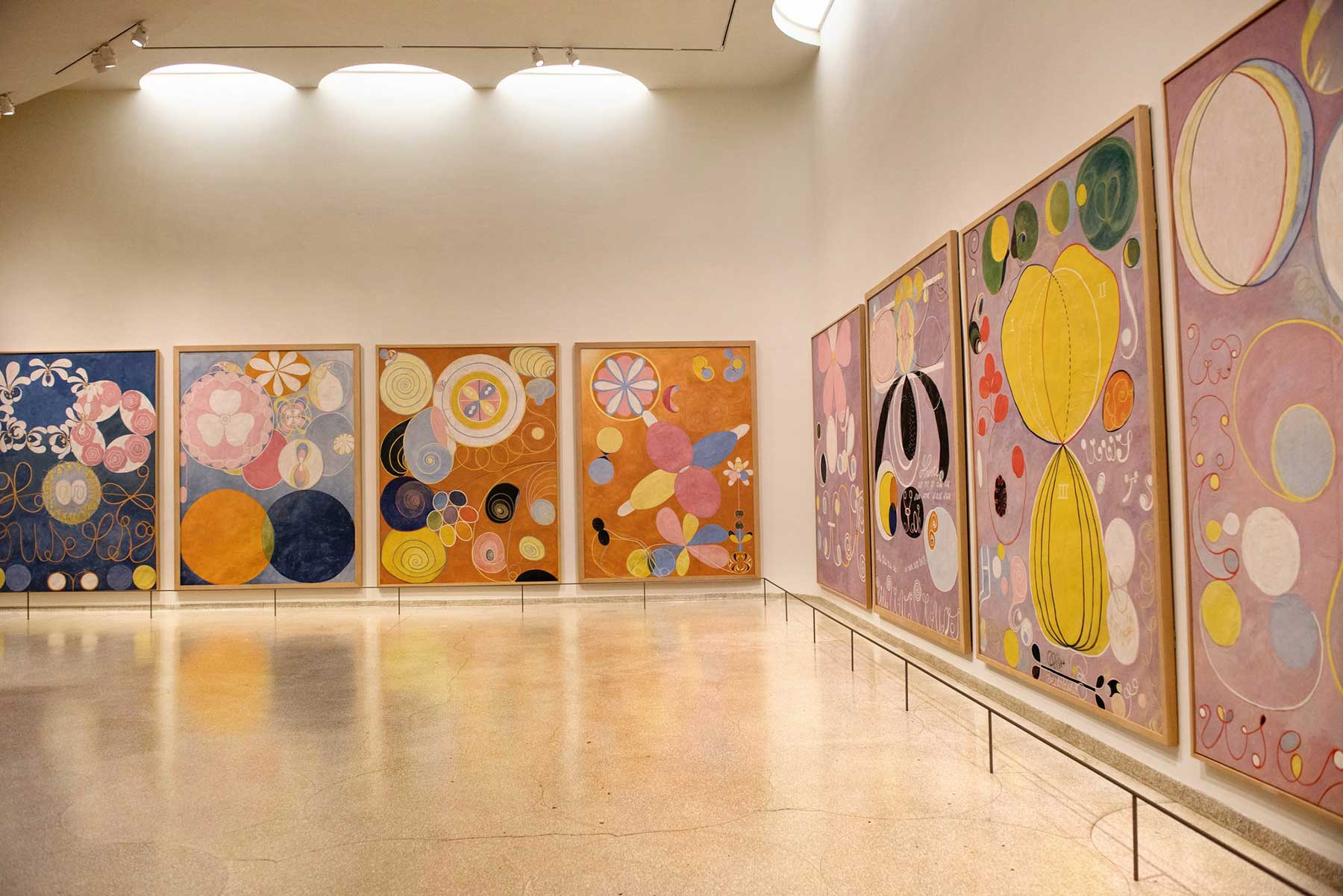
The Ten Largest (Paintings for the Temple Series)
Later works
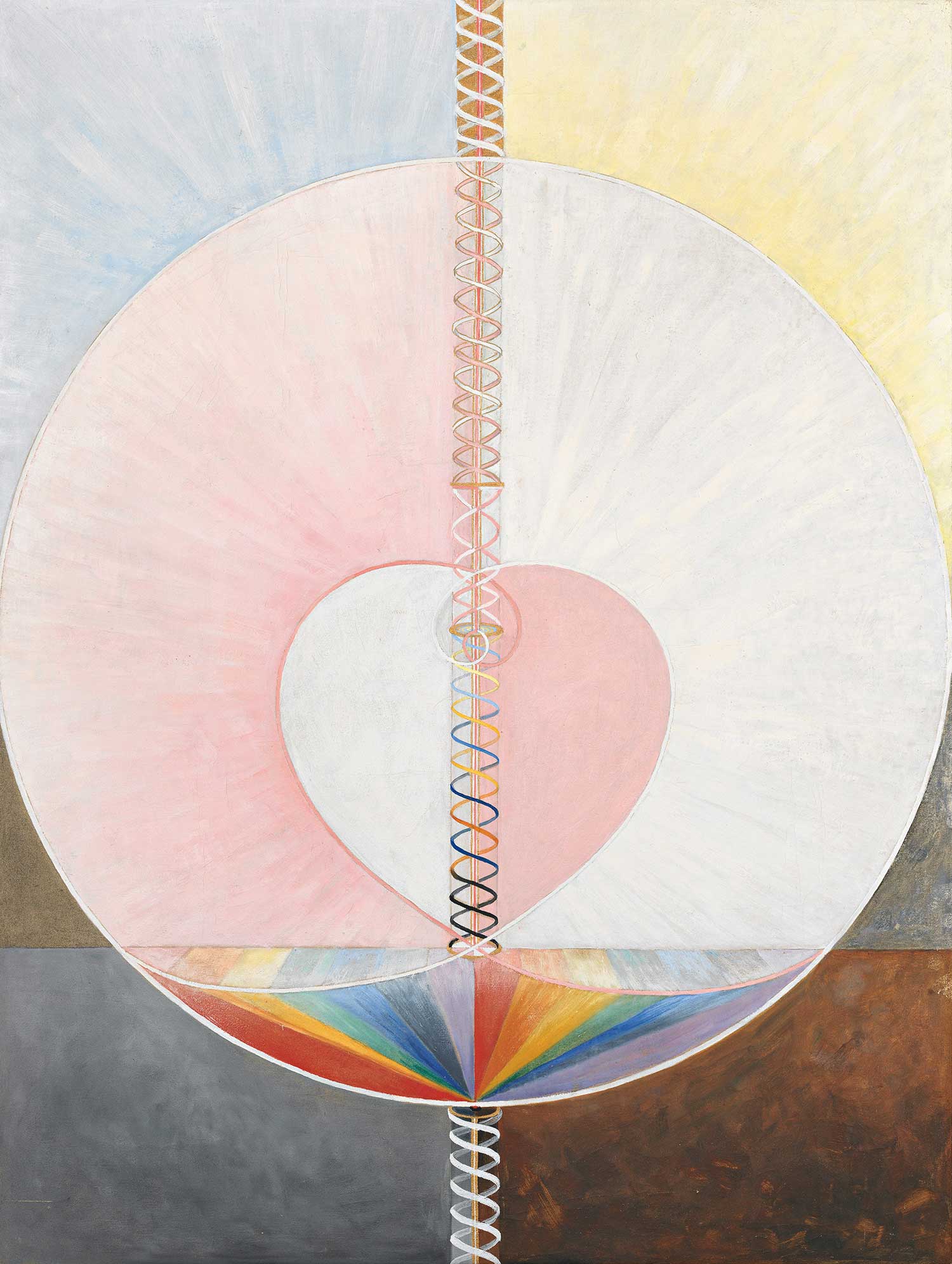
The Dove, No. 1, 1915
After 1915, once the Paintings for the Temple had been completed, af Klint recorded that her ‘divine guidance’ had come to an end. In turn, the artist’s approach to painting, mainly according to size and medium, changed. Firstly her oil paintings on canvas became smaller (as had been previously in her Primordial Chaos series) and then she began to experiment with watercolor on paper, returning to a more “automatic” process adopted in early meetings with ‘The Five’. During 1917 she wrote over 1,200 pages entitled (Studies of the Life of the Soul), detailing her experience as a metaphysical medium.
Her mother died in 1920, and subsequently she began another highly creative year, predominantly exploring world religions and studying the scientific intricacies of flowers and trees. She moved to Helsingborg, a coastal city in Southern Sweden, and between 1921 and 1930 often visited the Goetheanum in Switzerland (the world center for the Anthroposophy Movement), joining the Anthroposophy society, meeting Rudolf Steiner again, and becoming deeply immersed in his theories and ideas. During this time, af Klint was highly concerned with the legacy of her own work, cataloguing and photographing her paintings, documenting her practice, writing in her journals and sketchbooks, and reviewing previous discoveries. At an old age, she insightfully understood that her works would not be appreciated by the audience of her time, so she left all of her creations to her nephew, stipulating in her will that they should only be made public twenty years after her death. When she died in 1944, almost 82 years old, none of her abstract works had ever been shown to the public.
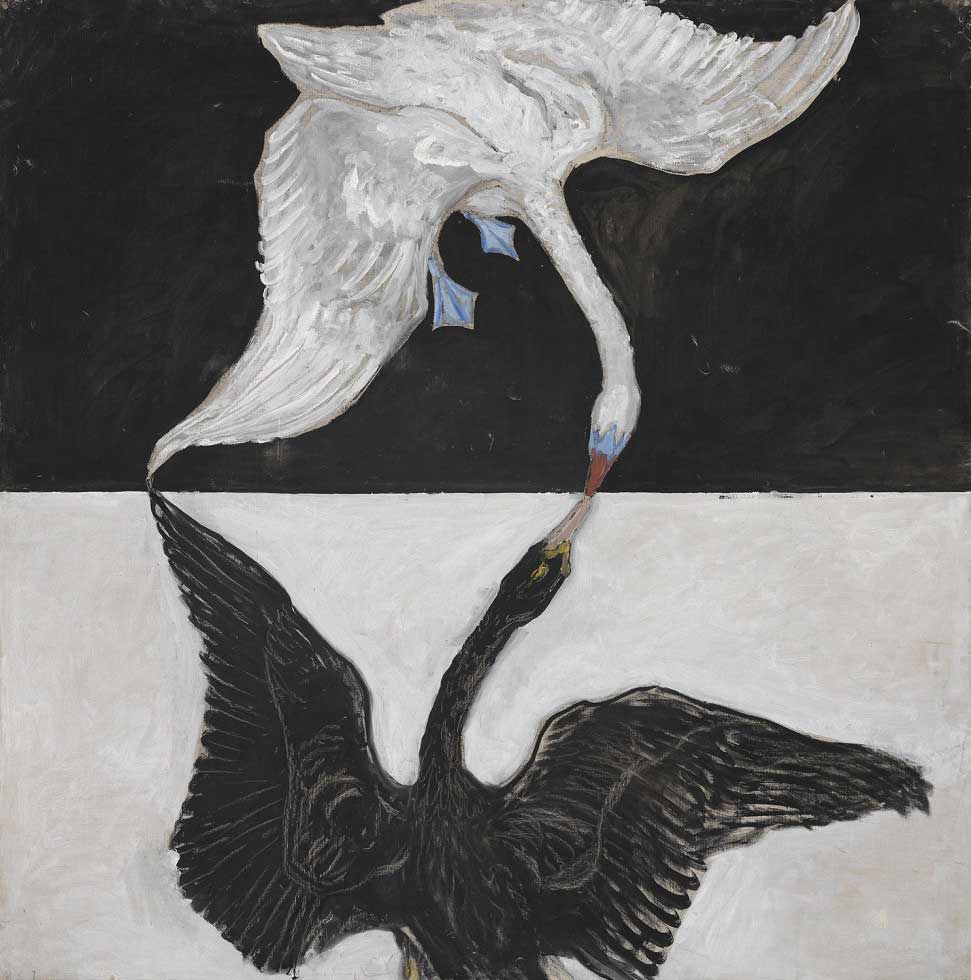
Swan No. 1 1914-1915
The Legacy of Hilma af Klint
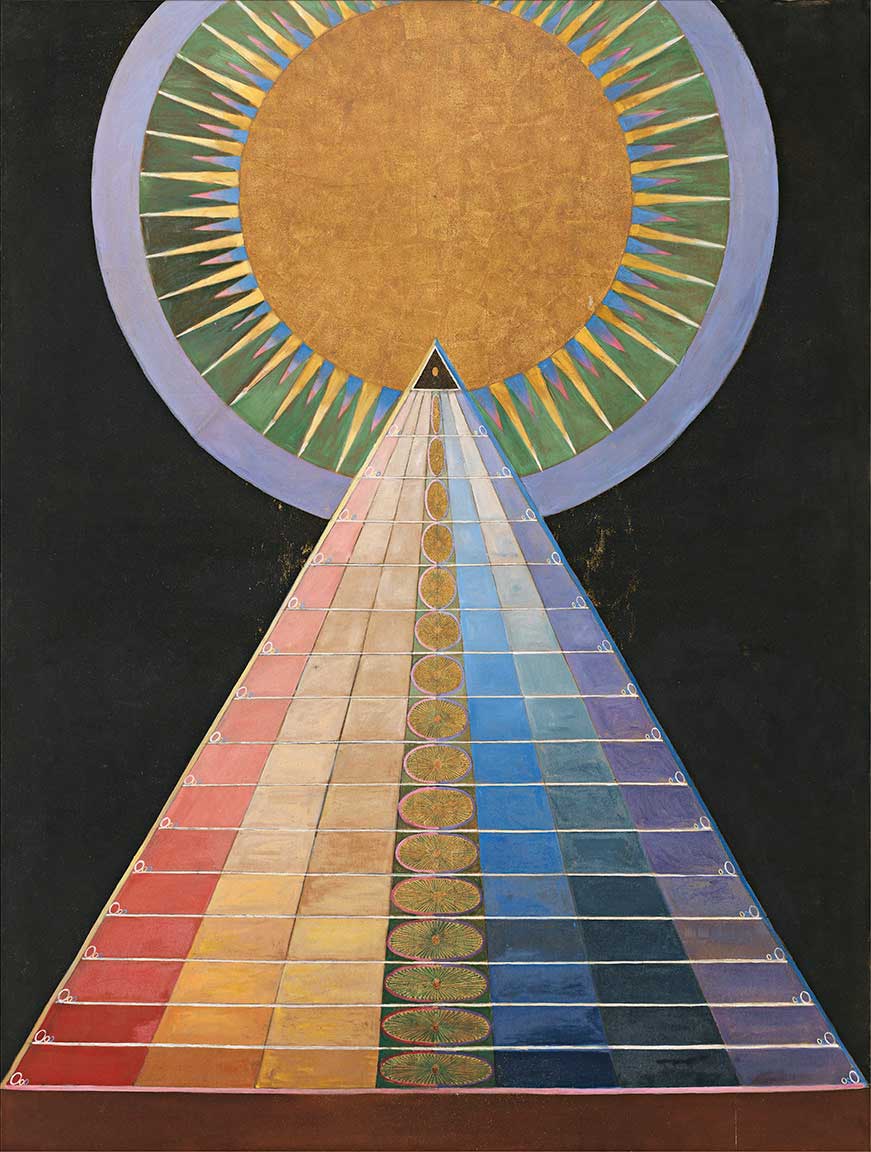
Altarpiece No. 1, 1915
Hilma af Klint did not have any contact with the modern movements of her time, yet she is now generally considered (whether useful or not) to be the pioneer and inventor of abstract art – her first abstract work was painted in 1906, which pre-dates Kandisnky’s by five years. Because of this new understanding, according to art critic Mark Hudson, she has “become one of the great unlikely buzz-figures of our time”. This delayed appreciation is due in part to her own wishes, which only made her works, comprising over 1,200 paintings, 100 texts, and 26,000 pages of notes and sketches, available to the public decades after her death.
One of her paintings was shown in 1986, in a collective exhibition in Los Angeles entitled The Spiritual in Art, yet her work only began to become more widely acclaimed after 2013, when the Modern Museum in Stockholm hosted an exhibition dedicated solely to her work. The lull in time before her ‘discovery’ is also due to the fact that af Klint did not participate in any form of self-promotion and thus the stamp of legitimacy from the art world took a long time to find her.
As explained by the Stockholm Moderna Museet exhibition catalogue (2013), af Klint’s “abstract pioneer spirit is not crucial when we now encounter her work on a larger scale”. It is the underlying spirituality, the main source of inspiration and creativity in all her work that defines her artistic contribution to the world. Now, she is generally considered a ‘woman ahead of her time’, a mystical painter, and a ‘cartographer of the spirit’, an expression coined by art critic Kate Kellaway. All of her works belong to the Hilma af Klint Foundation and the impact of her creation is only now coming to be understood. As a human able to renounce the ego at a time in history when building a cult of personality was often a key to success, a full appreciation of af Klint’s work involves following a path of intuitive intelligence which many viewers find challenging.
Although we remain far away from the entirely harmonious world that af Klint was working towards, it seems that it is within small collaborative groups where this ideal model can be successfully rehearsed. Furthermore, there are other contemporary artists currently making powerful artwork shared and critiqued principally by other artists rather than by critics and gallerists. This is an individual decision based on the realization that self-promotion can be a distraction when the goal is to facilitate true meaning. Af Klint assures young artists that ‘hiding’ one’s work does not mean that it is not still ‘seen’. Seventy years after her death, Hilma af Klint’s moment has come.
“Those granted the gift of seeing more deeply can see beyond form and concentrate on the wondrous aspect hiding behind every form, which is called life.”
– Hilma af Klint
Symbols in Hilma af Klint’s imagery
Hilma af Klint’s imagery is full of symbols, letters and words. Symbols are like doors into another dimension. For Hilma af Klint, her entire work was about conveying the messages she received, and to shed light on the great existential issues.
It would be pointless to translate the symbols and letters in Hilma af Klint’s works into definite, unambiguous terms. They must always be seen in relation to the entire context. In her notebook (Notes on Letters and Words pertaining to Works by Hilma af Klint) she attempts to clarify the complex meanings of the various signs.
Here are a few general explanations:
- The snail or spiral represents development or evolution.
Blue and yellow, and the lily and the rose represent femininity and masculinity respectively. - Green is union of feminine and masculine (blue and yellow make green)
- W stands for matter, while U stands for spirit.
- The almond shape arising when two circles overlap is called the vesica piscis and is an ancient symbol for unity and completion.
- The swan represents the ethereal in many mythologies and religions and stands for completion in the alchemical tradition.
- In Christianity, the dove represents the holy spirit and love.
ENJOY THIS SLIDESHOW OF SOME OF HER WORK…
Here’s a Pinterest board full of her work to inspire you!
Studioworks Homework
I highly recommend you watch this wonderful documentary about Hilma af Klint – so fascinating!
Master Artist Guide
Sketchbook Explorations
EXPLORATION 1
Hilma af Klint inspired
As unusual as af Klint’s work is, look through it and see if you can find an element, color or concept that inspires you or you are curious about. Go ahead and create with her as your Muse. I chose to do a 20 minutes meditation and then draw intuitively with charcoal. As usual, I started with my non-dominant hand. I allowed myself to be inspired by some of af Klint’s symbols like the dove and the spiral. I went on to paint the piece with colors from her work, following her color symbolism as mentioned before. Alternatively, you could do a study of one of her works and copy directly from a piece that inspires you. Explore what feelings come up as you create this way. Use this exploration as a great opportunity to connect to your Artist’s Soul.
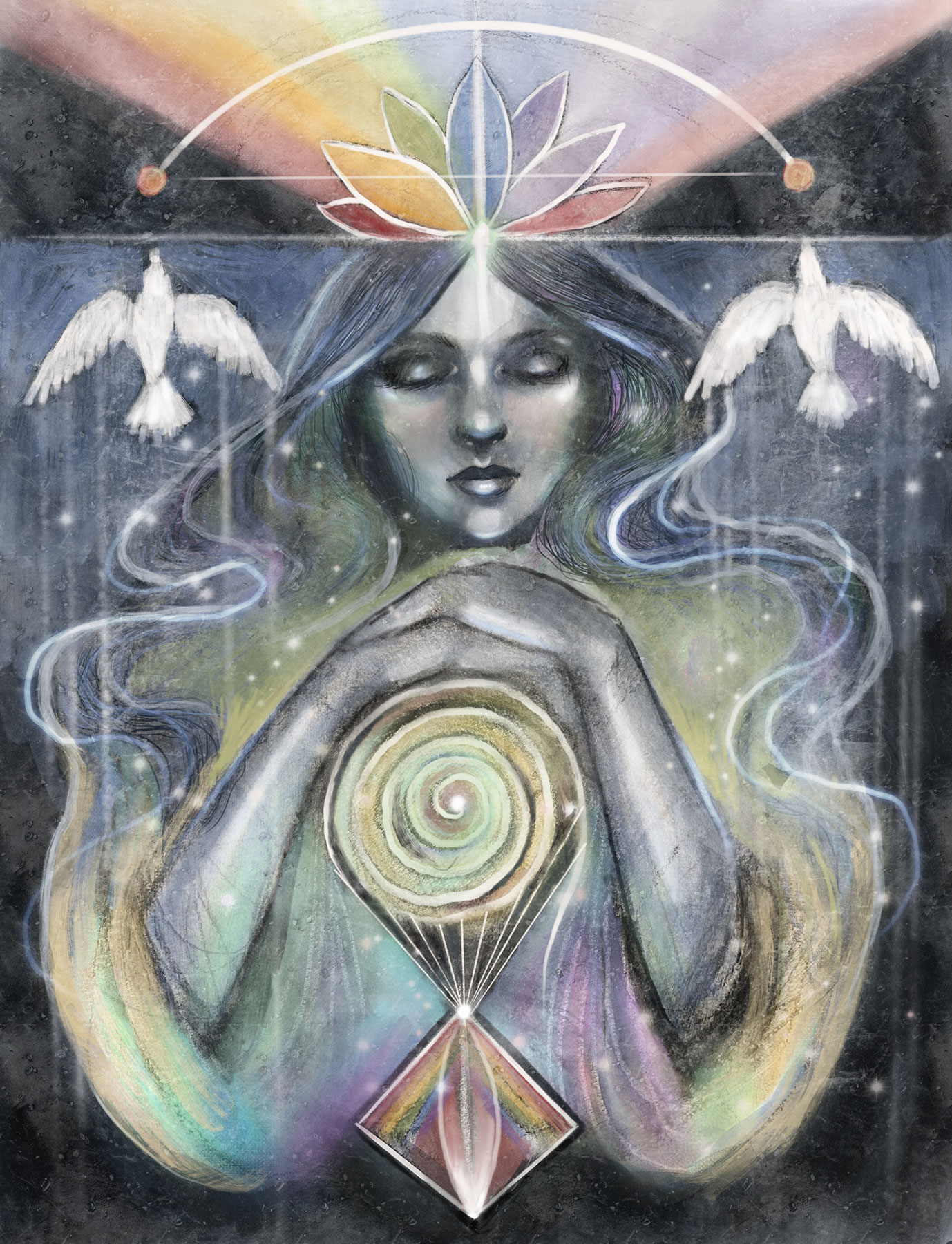
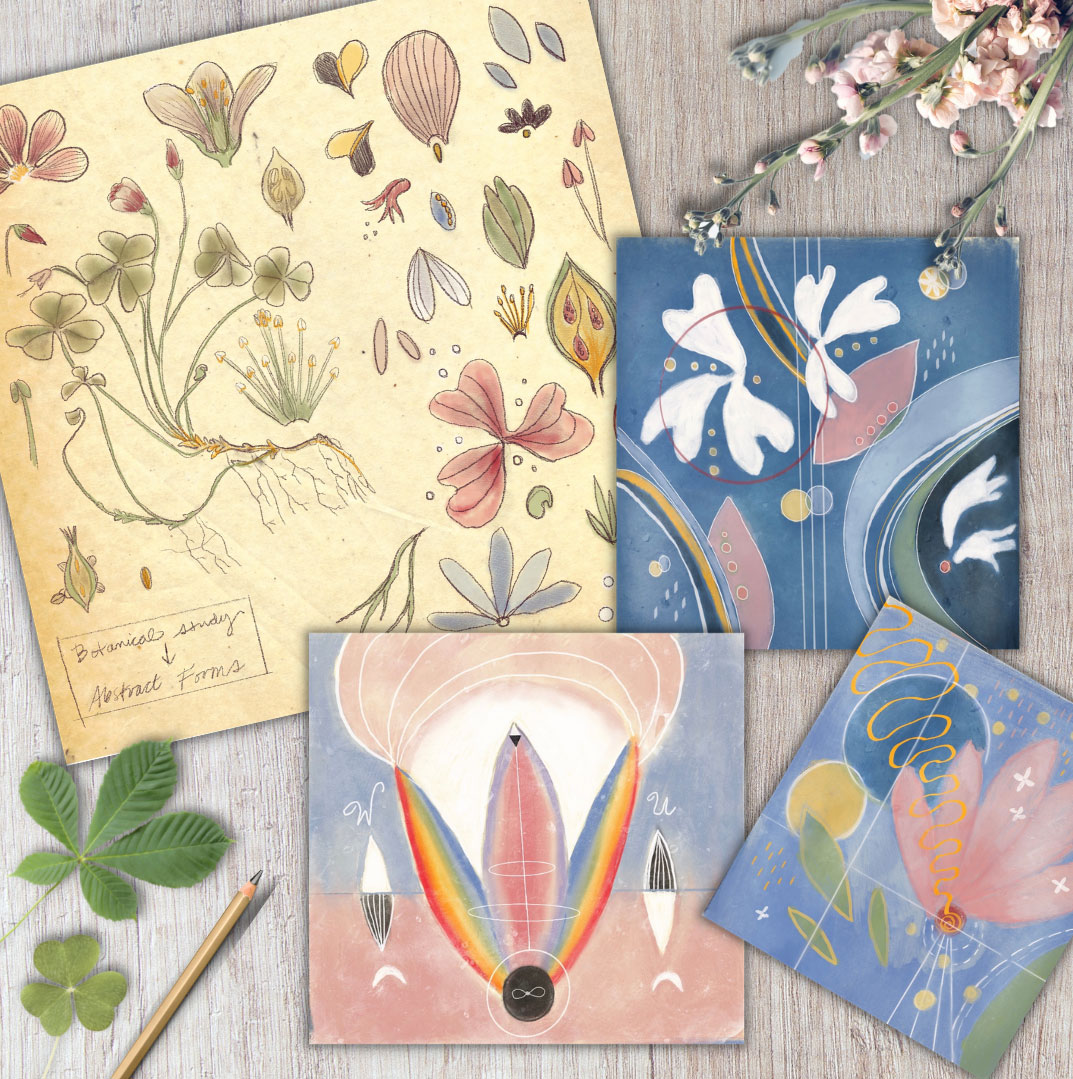
EXPLORATION 2
Botanically inspired
Hilma was greatly influenced by the natural world. She studied botany and worked as an illustrator for a veterinary practice. So let’s gain some insight into the magic of nature by doing some studies of flora and fauna. Either look at the plants and animals around you or get inspired and do a study from one of natural images I have gathered for you. (see Pinterest board below)
It’s interesting to note, that once we distill a form down to the cellular level you can see such a world of abstraction and geometry. We know Hilma recognized this connection as well.
“I want to acquire real insights about our existence on Earth, in relation to the center of the Universe. I will start with the world’s flowers.”
– Hilma af Klint
JULY ART PROJECT
Seeds of Life – By Dena Ann Adams
I’m so excited to share this beautiful lesson with our talented guest teacher – Dena Ann Adams – with you! She’s such a fantastic artist and teacher!
One of Dena’s favorite things to do is periodically venture far outside herself as an artist by looking to the works of those who have come before, and trying new experiments to see what resonates with her.
Dena came to art obsessed with abstraction and minimalism, long ago, and now she finds herself, in many ways, a traditional landscape painter! This creative session was a wonderful chance to revisit Hilma and go full circle.
Let’s begin…
STUDIOWORKS
Submission Calls
STUDIOWORKS PODCAST
issue thirty-one
You can also listen to this month’s issue of the Studioworks journal. I find I love listening to books, podcasts and music while I draw, paint or go on a long walk. Enjoy.
Studioworks : issue thirty-one
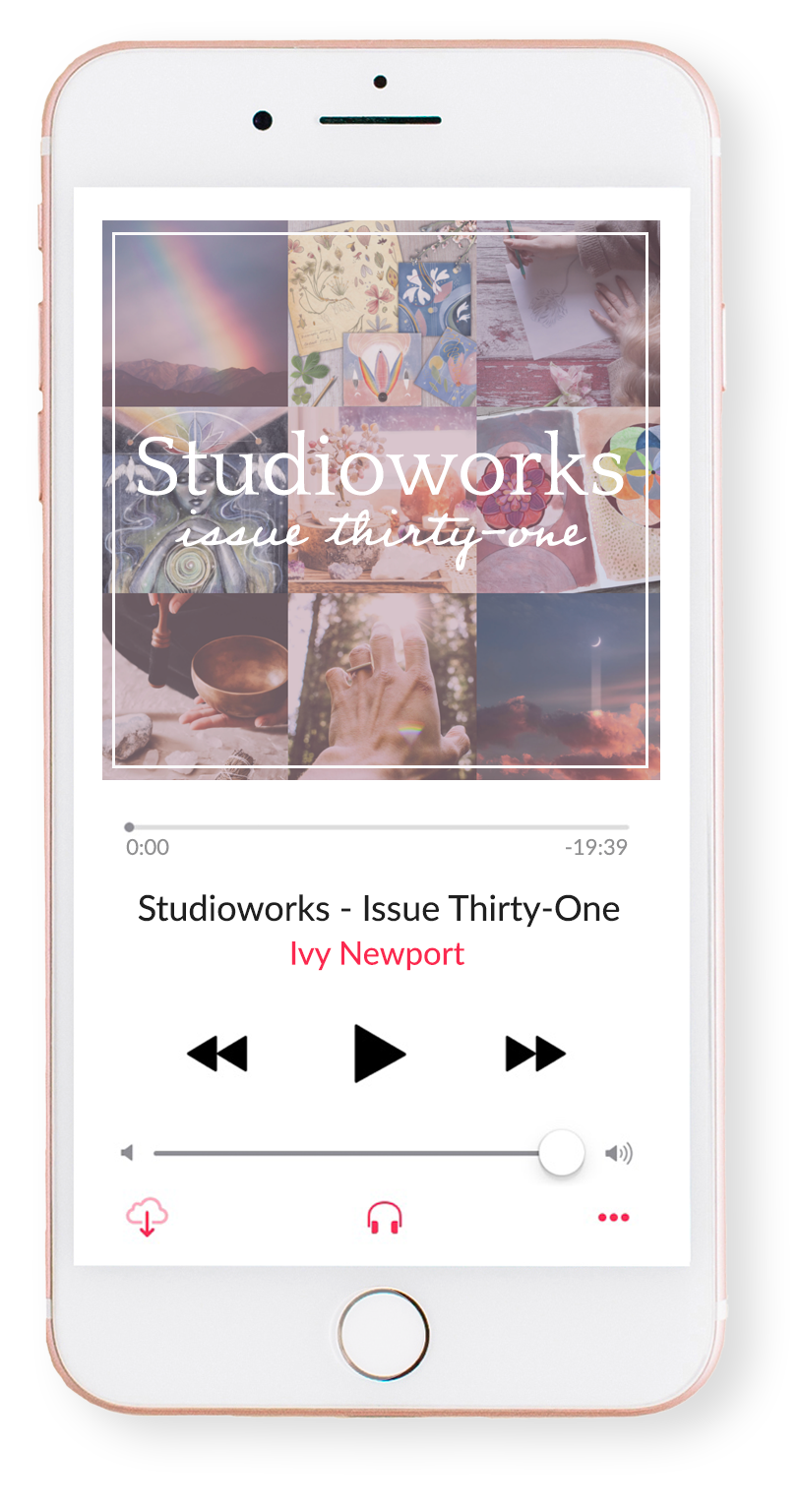
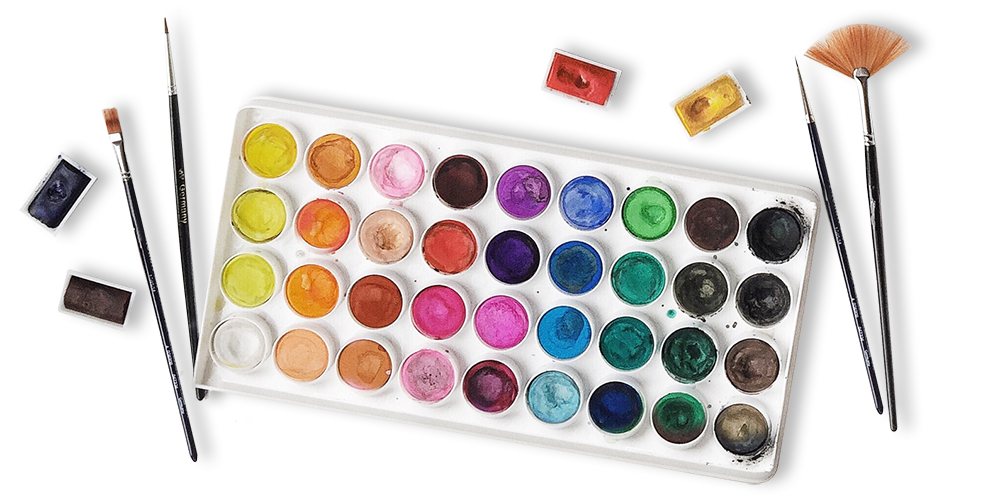
inspiration: curated
Books to Discover & Enjoy
MUSIC PLAYLIST
I had so much fun curating this list. I hope you enjoy!!
THINGS TO WATCH
PINTEREST BOARDS
CLASSES TO TRY
Here are just a few of our fantastic classes! They feel in alignment with this month’s issue! I highly recommend checking them out if you haven’t already. Enjoy!

© 2019 IVYNEWPORT, LLC ALL RIGHTS RESERVED.

